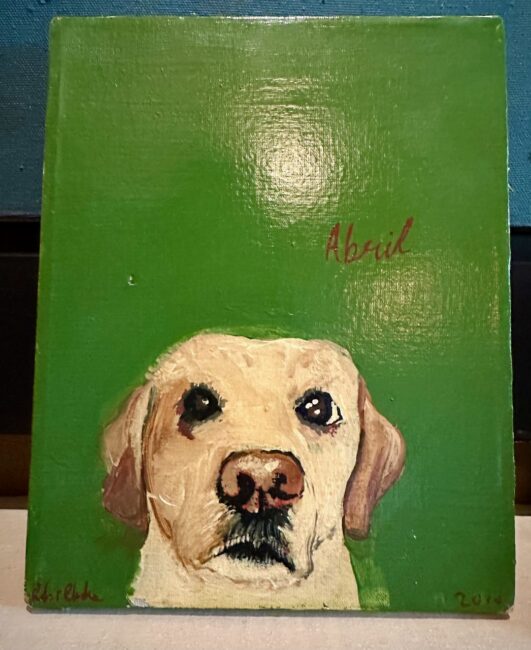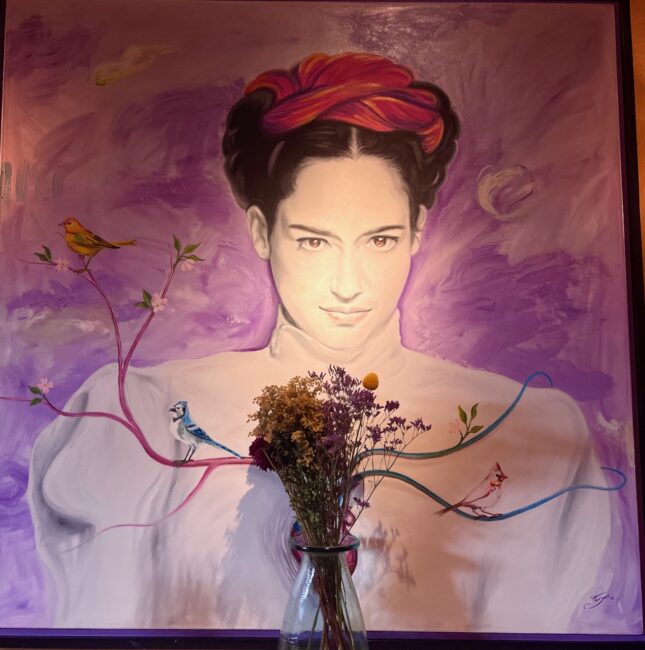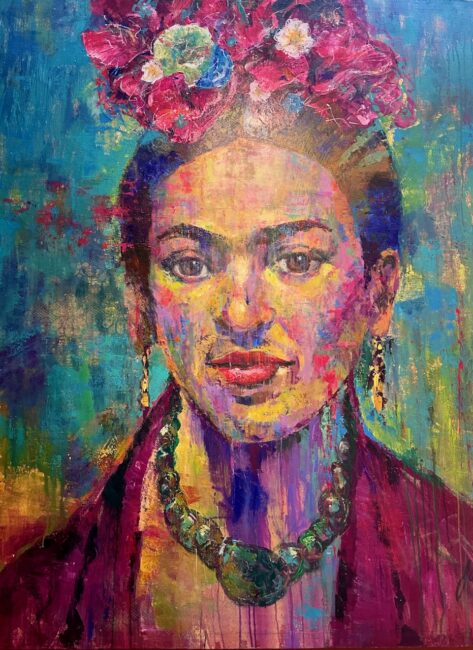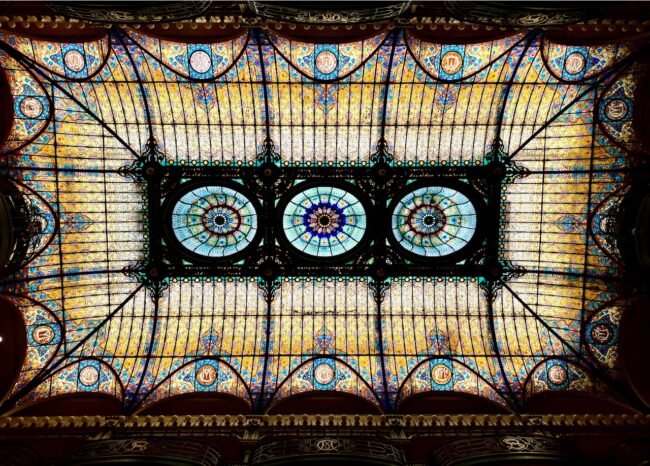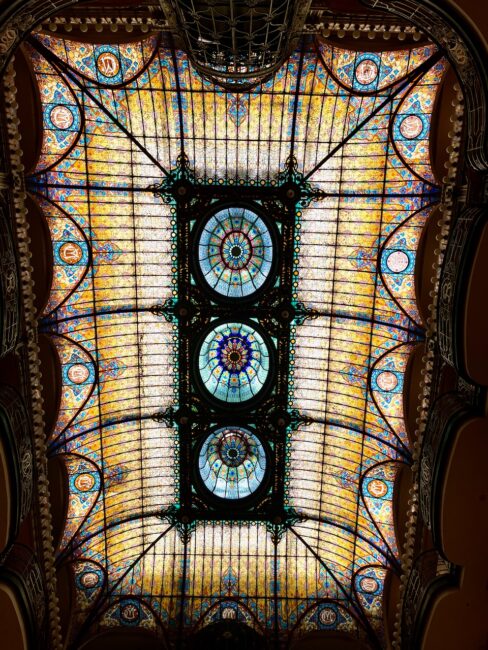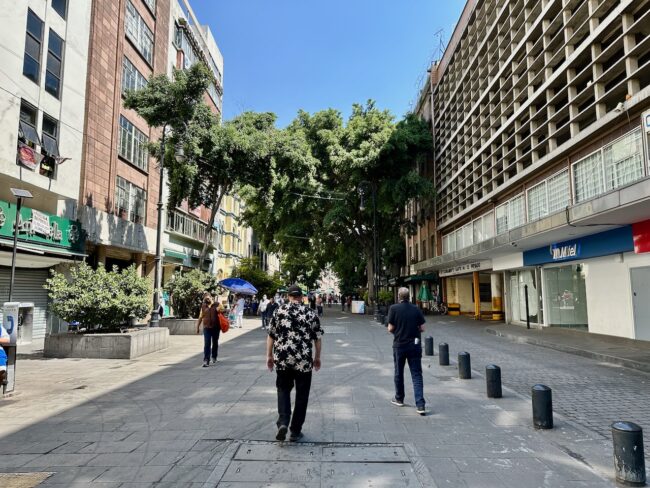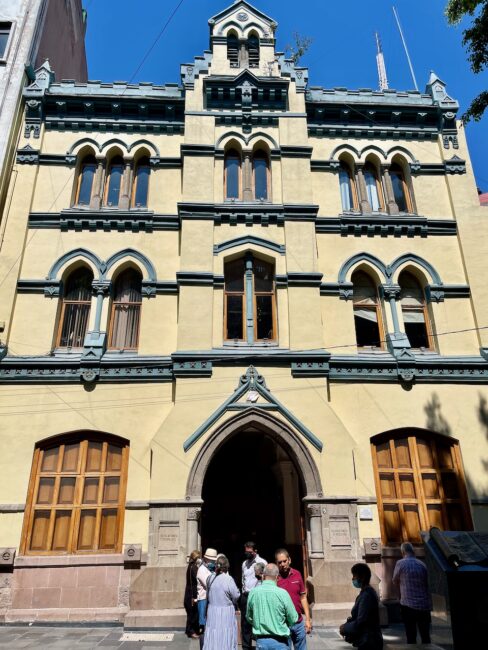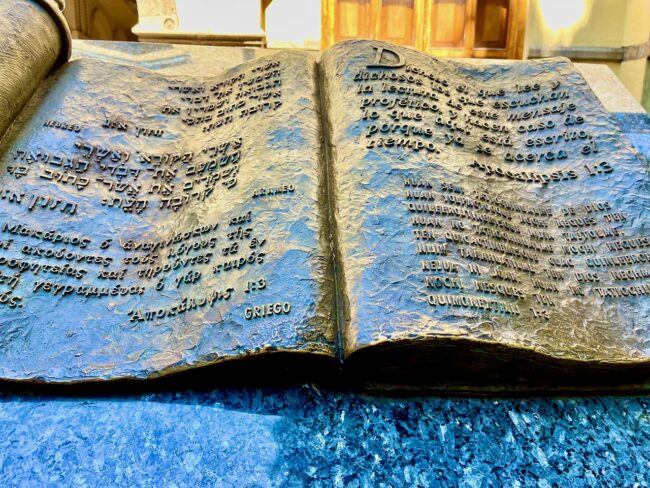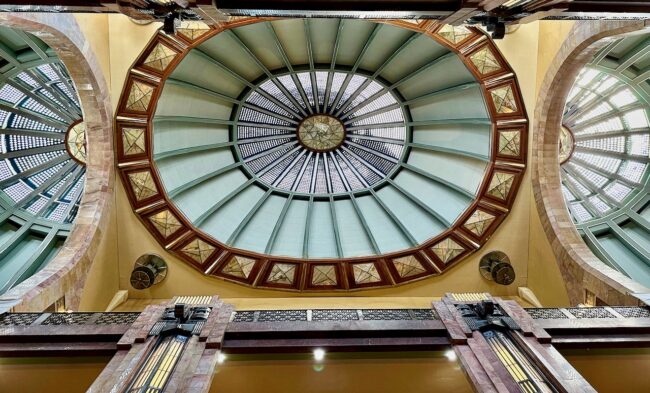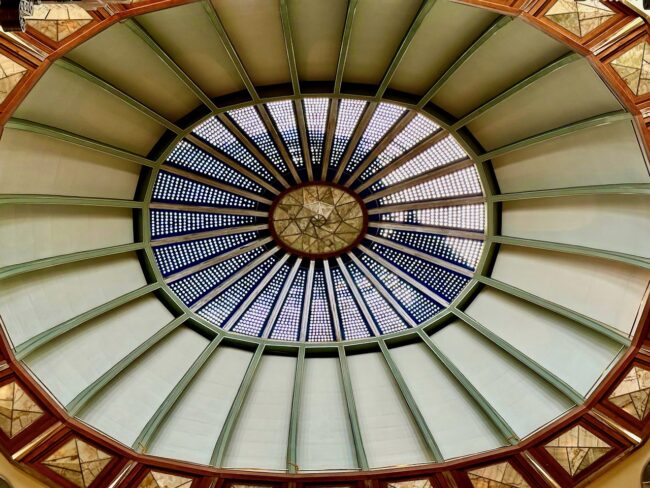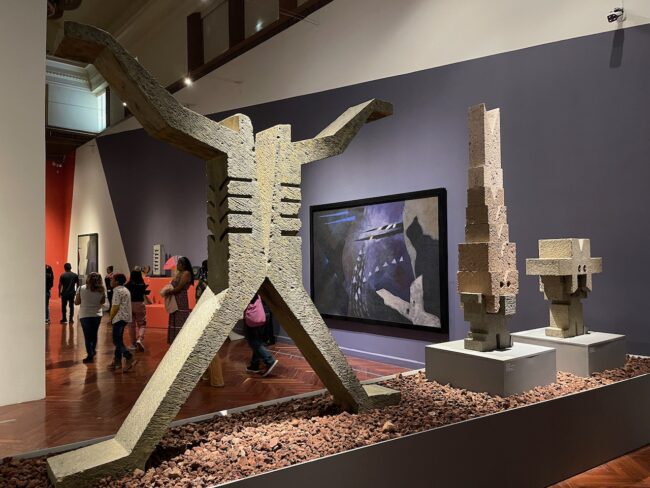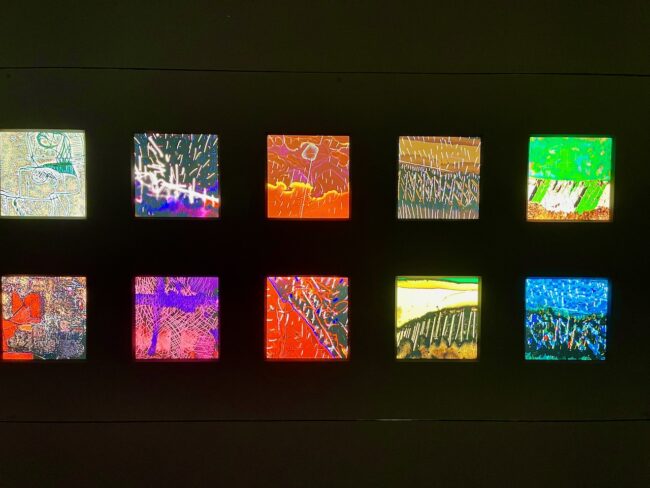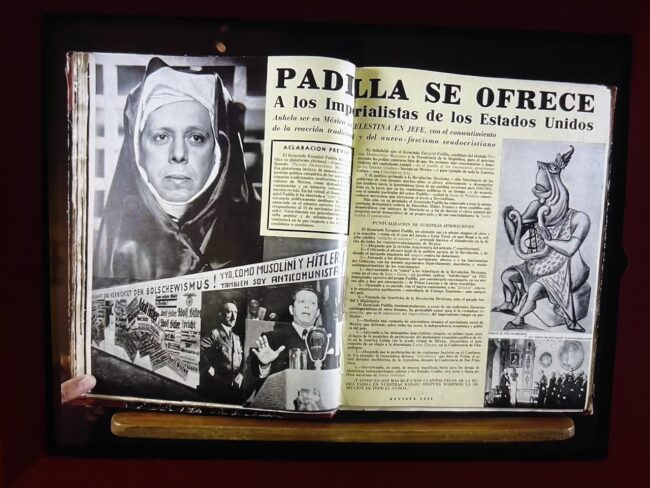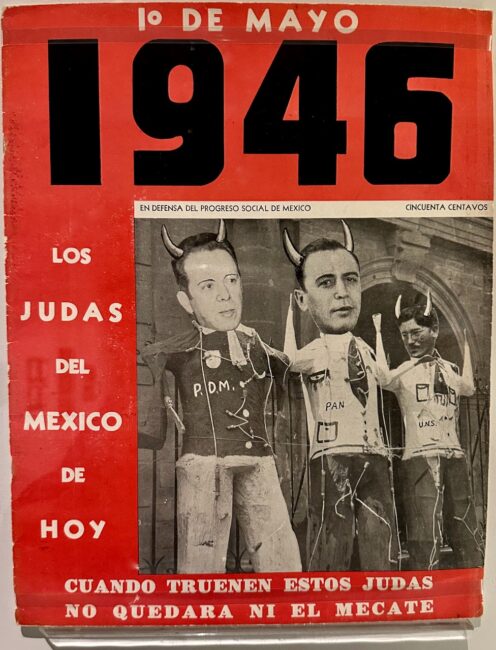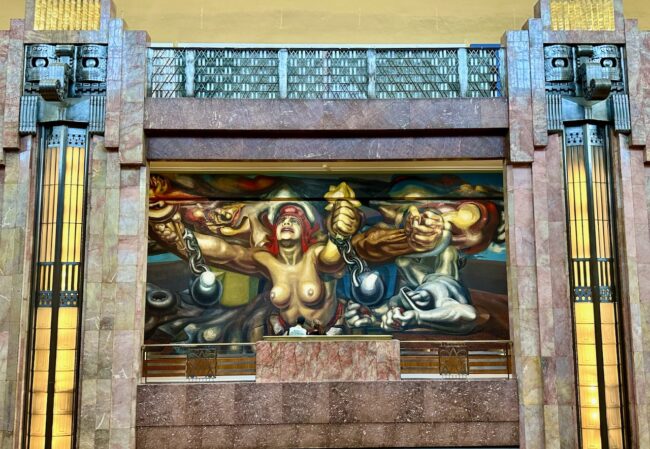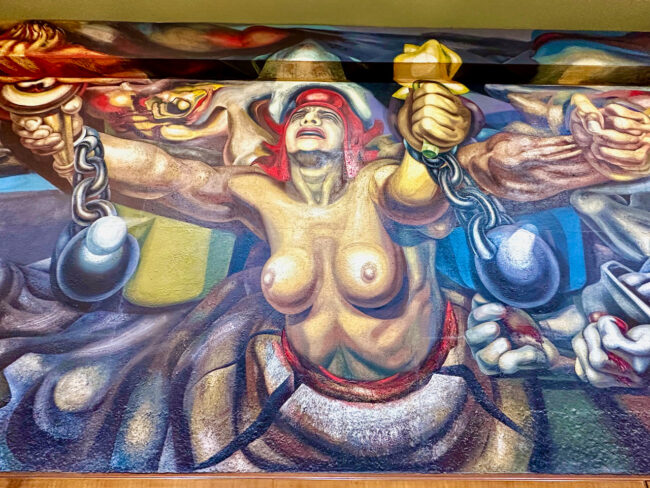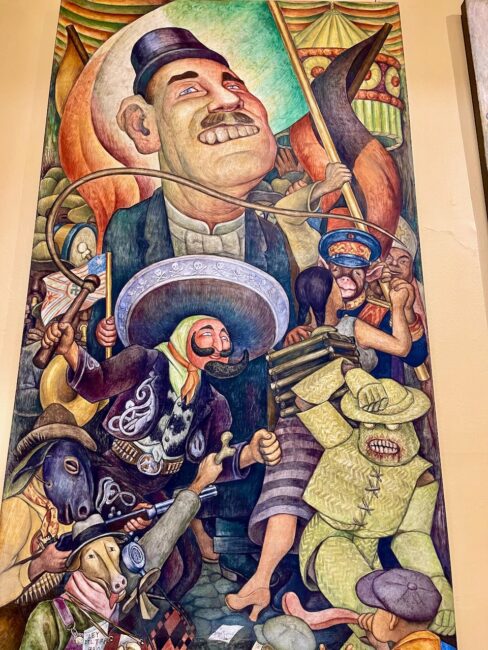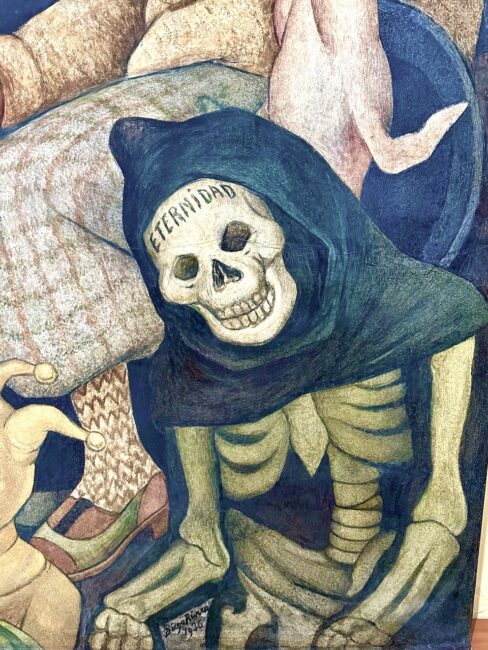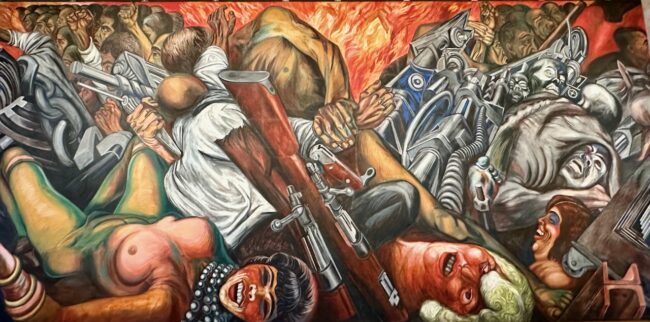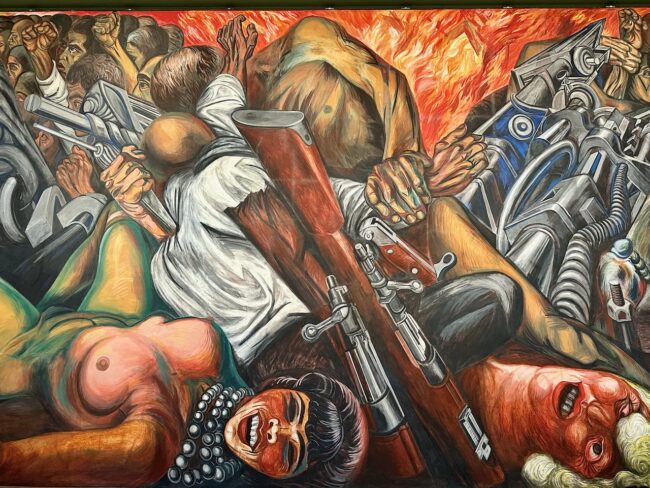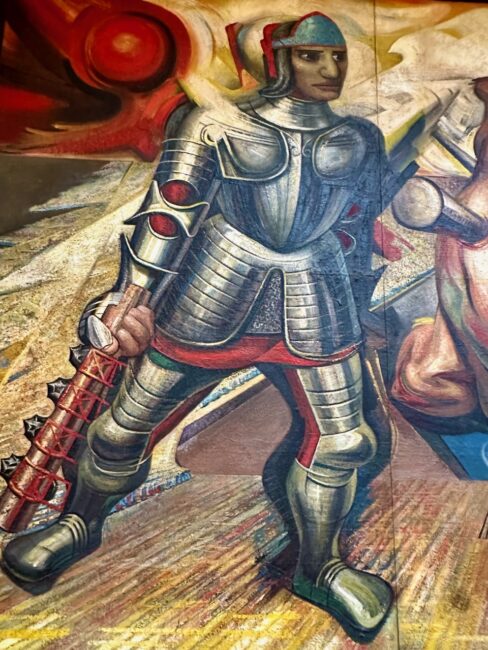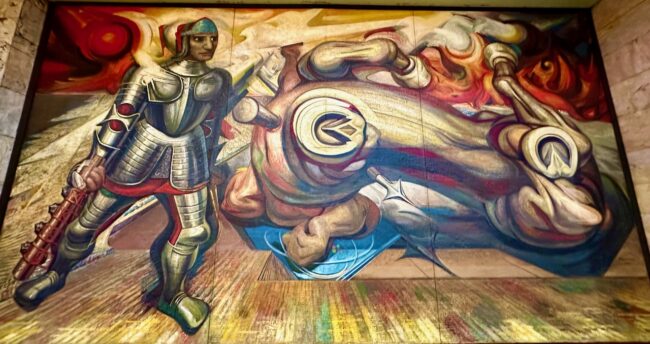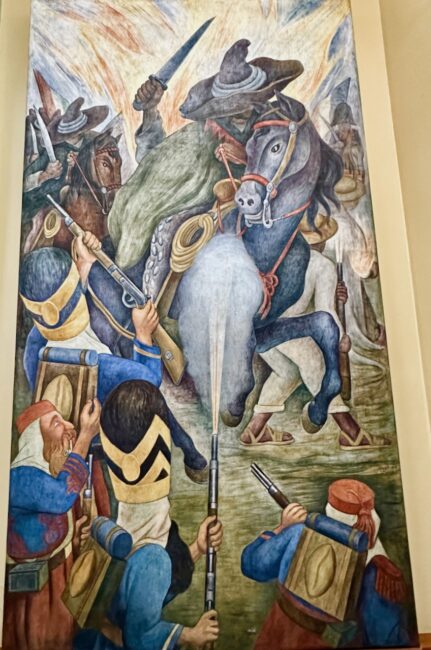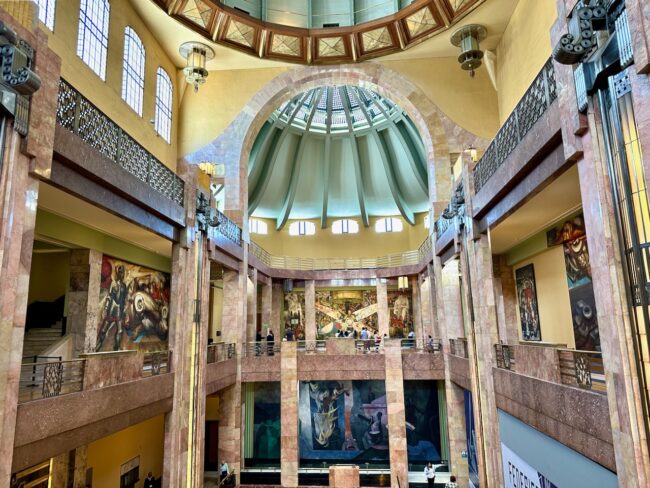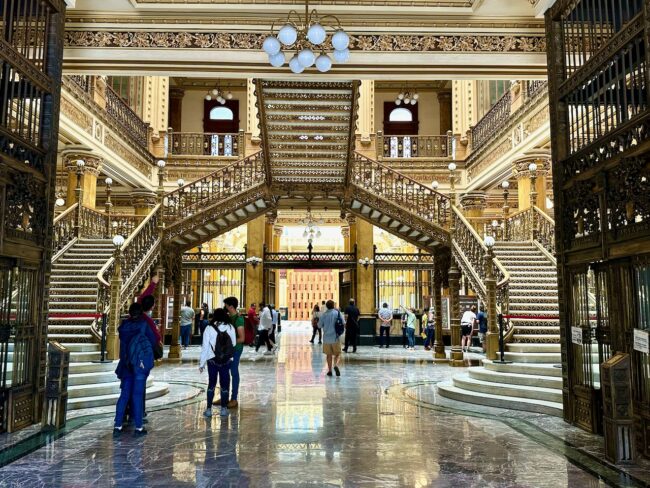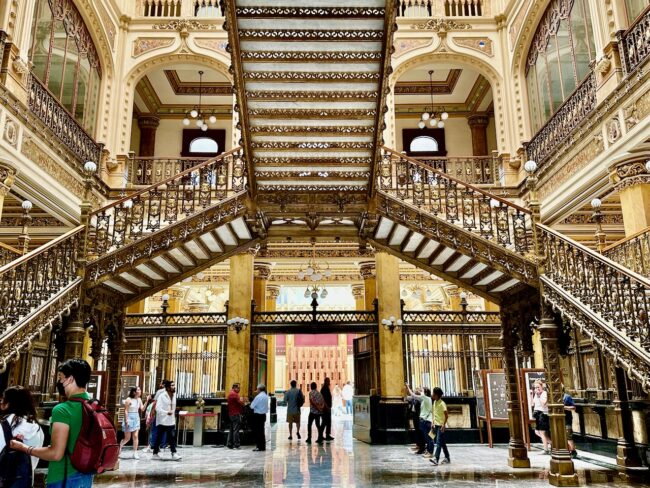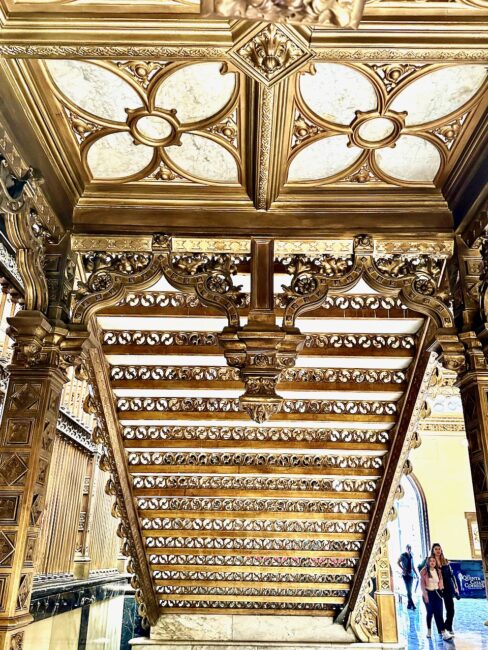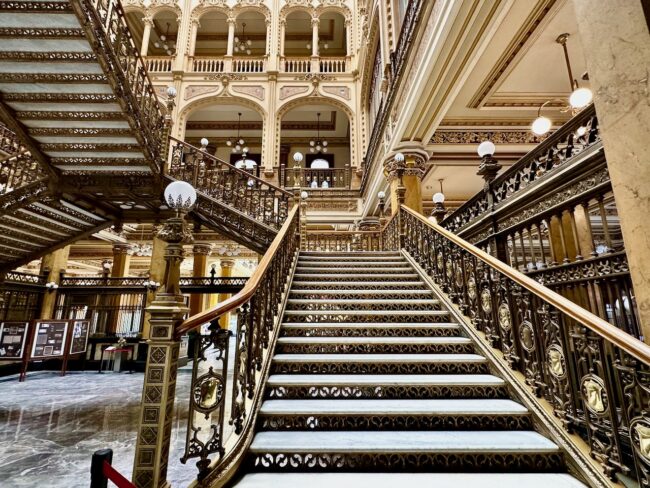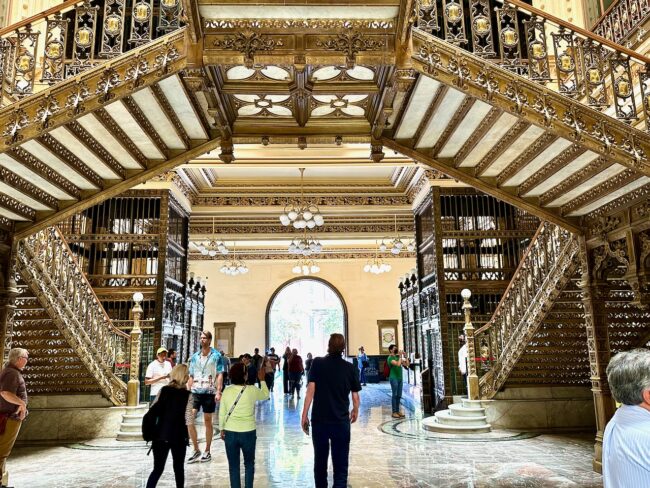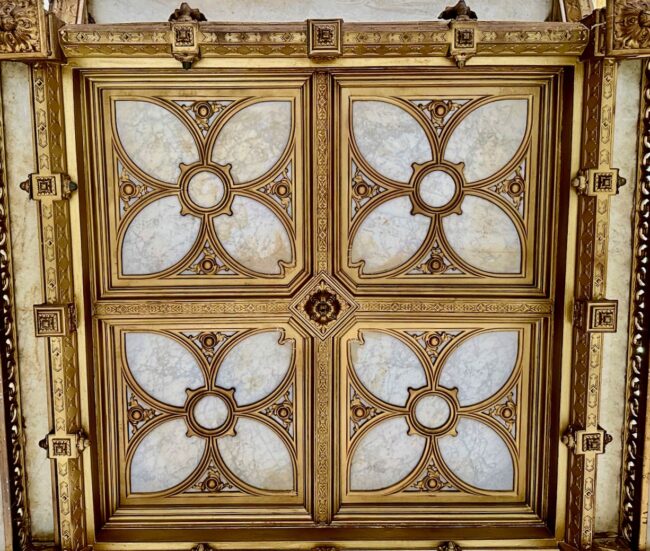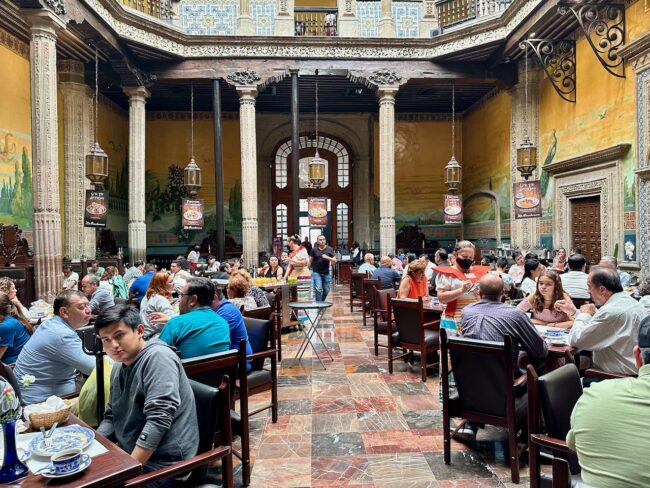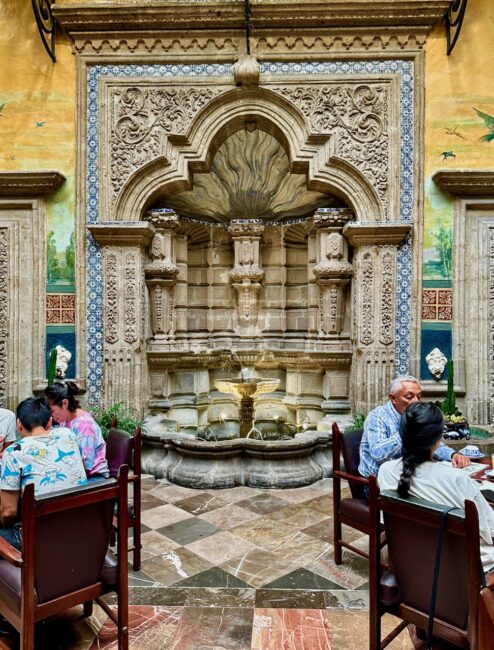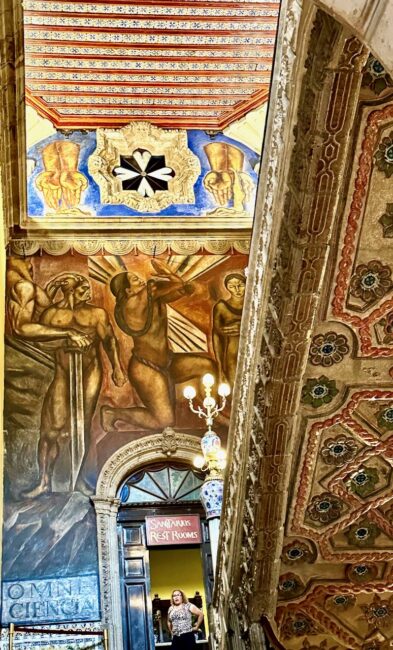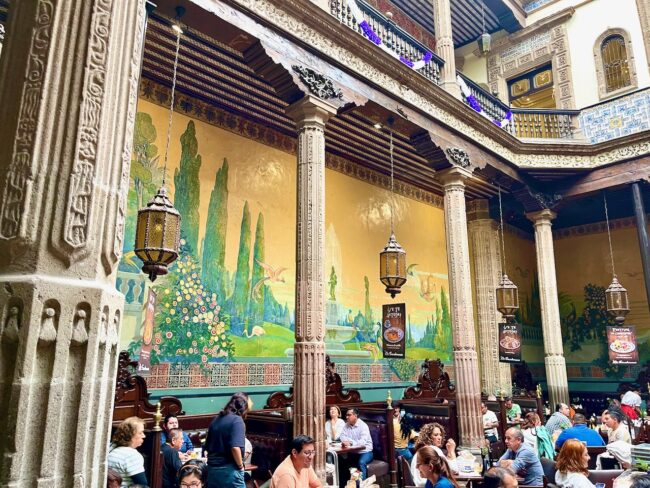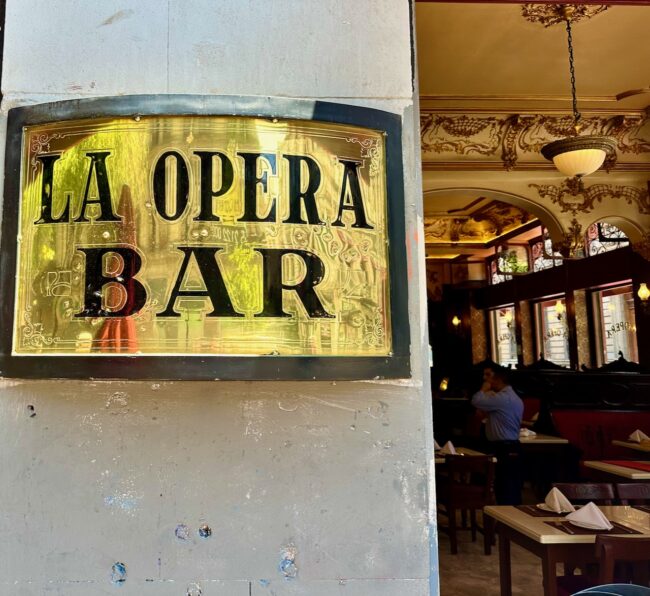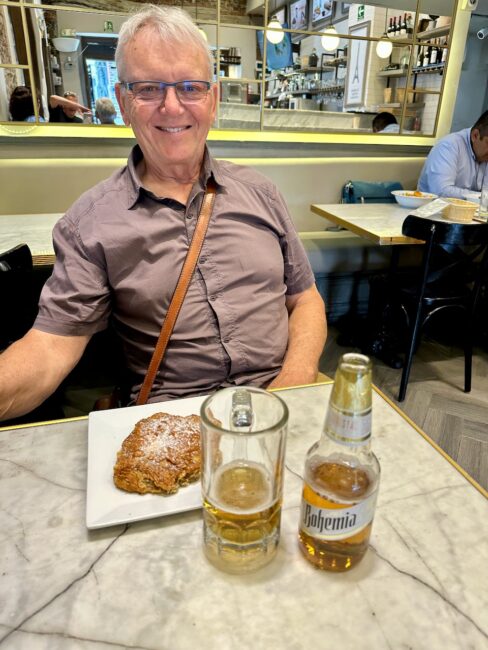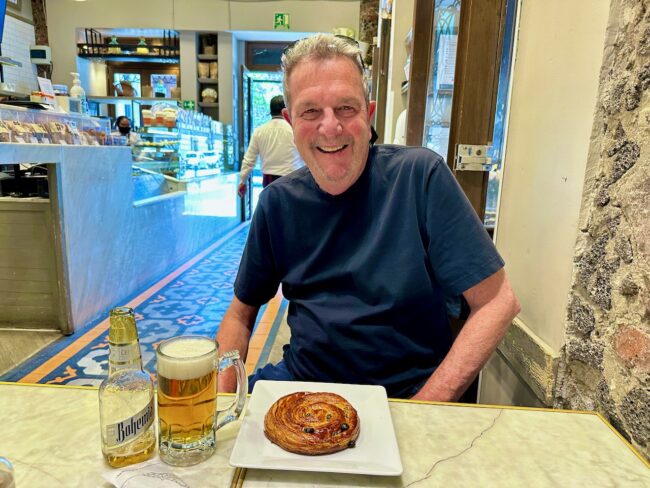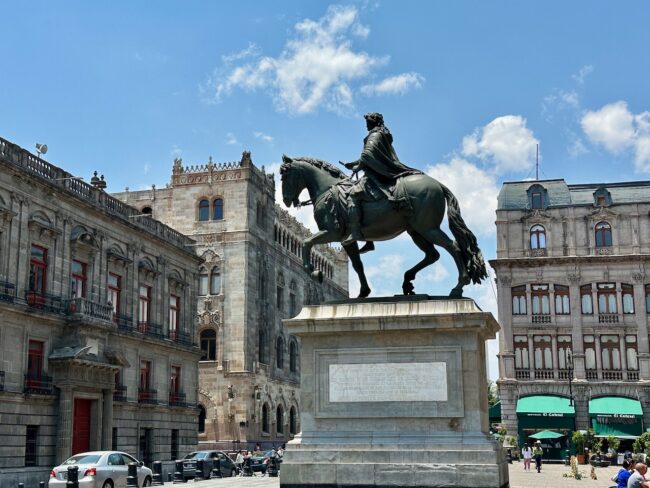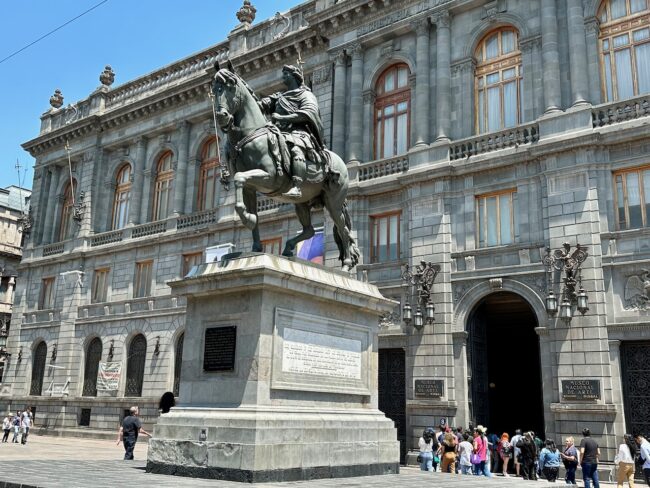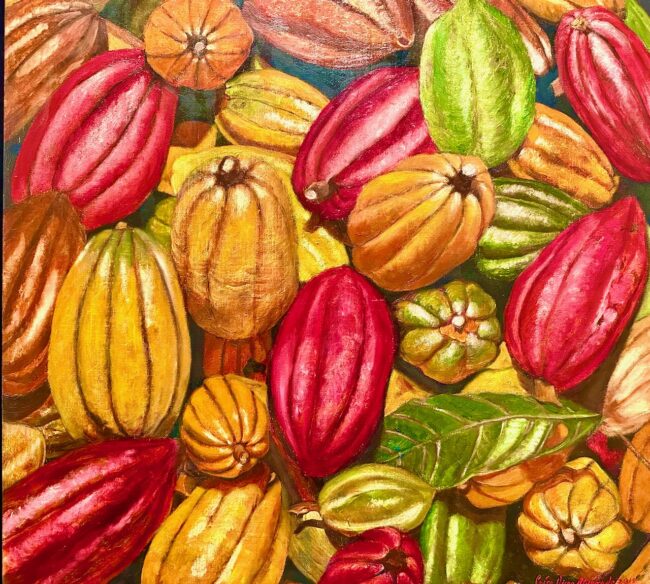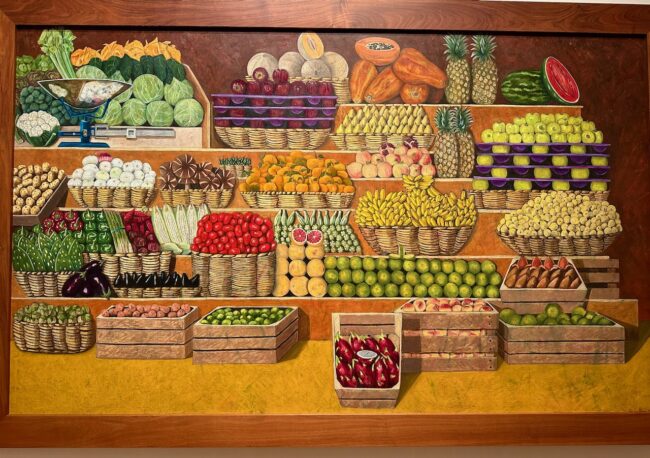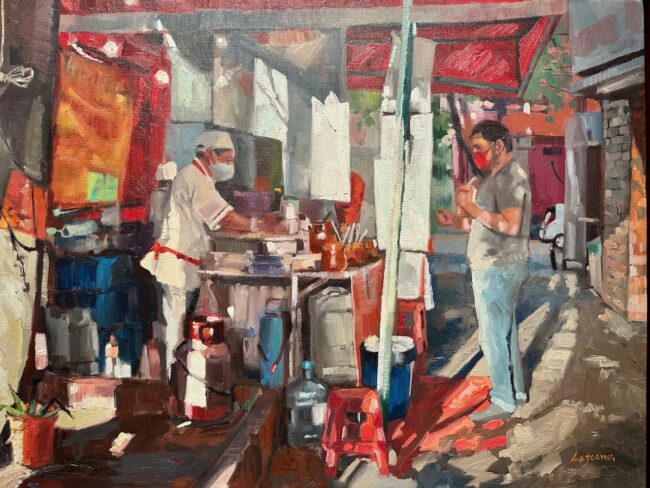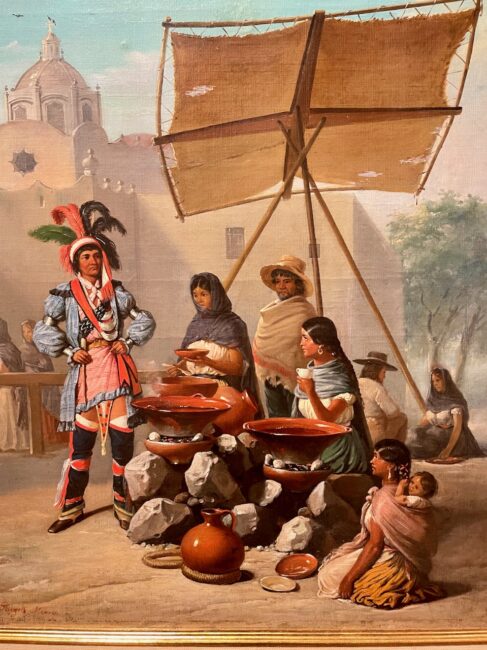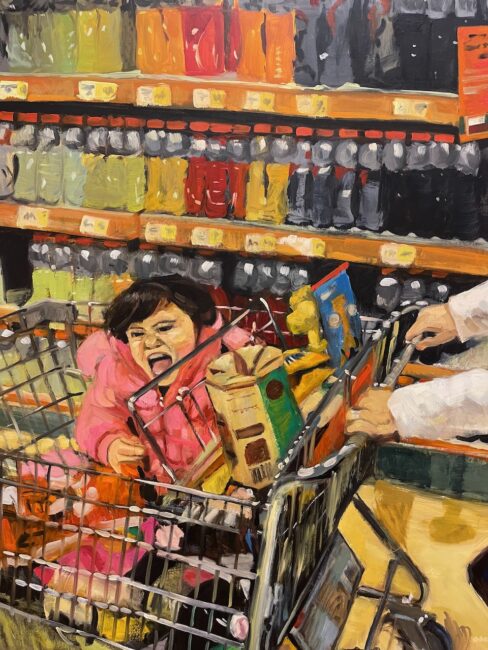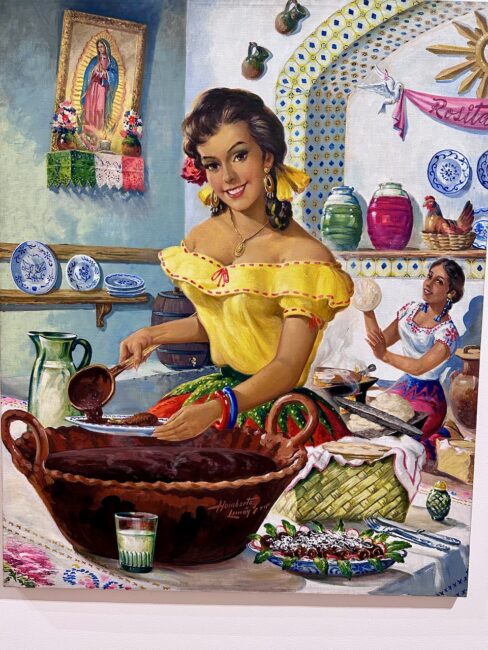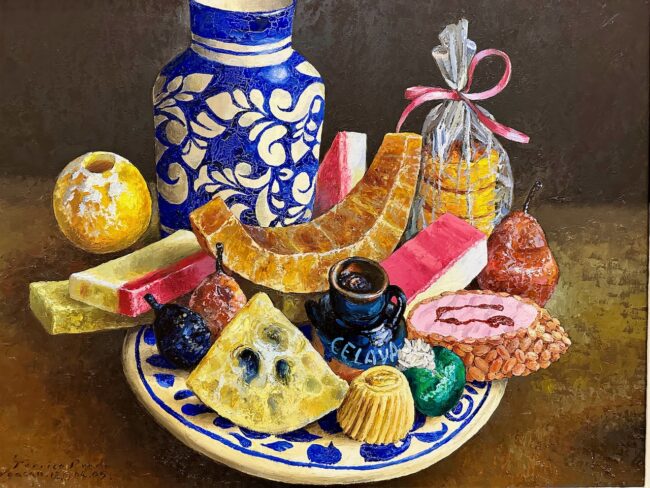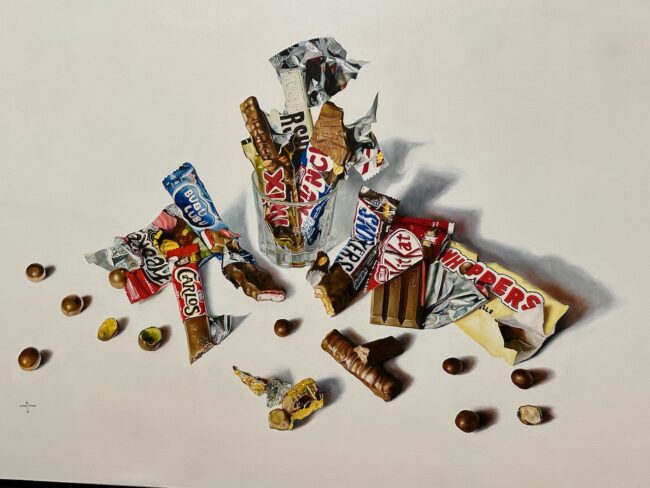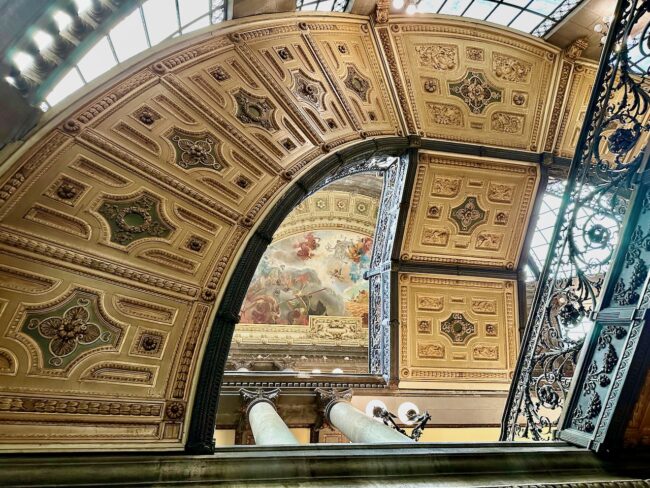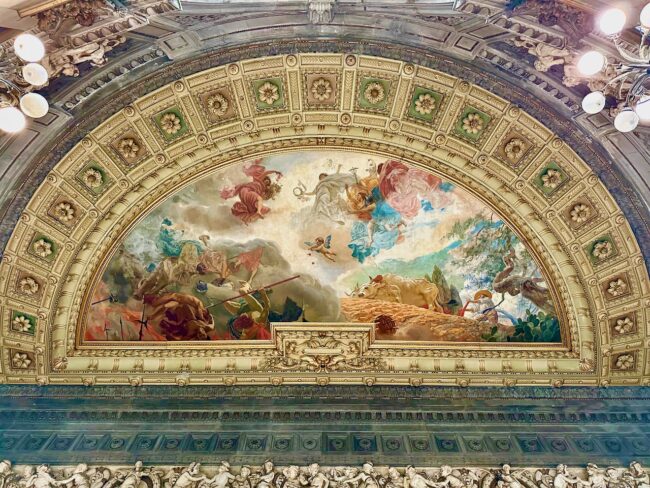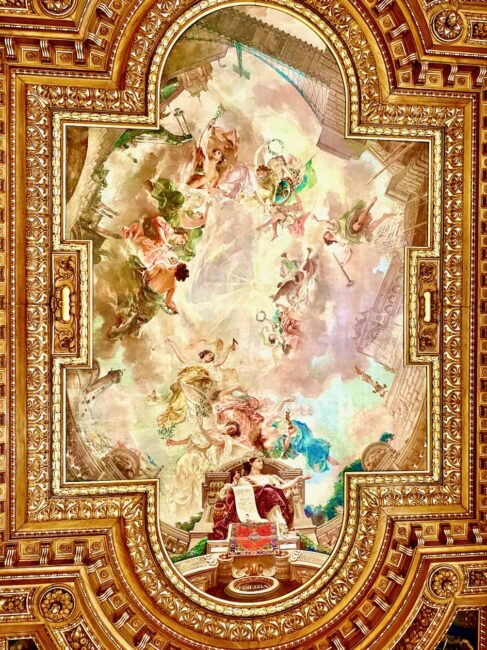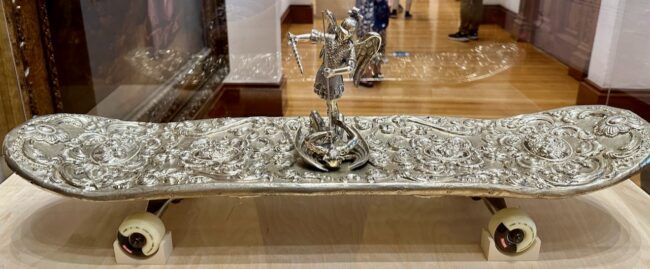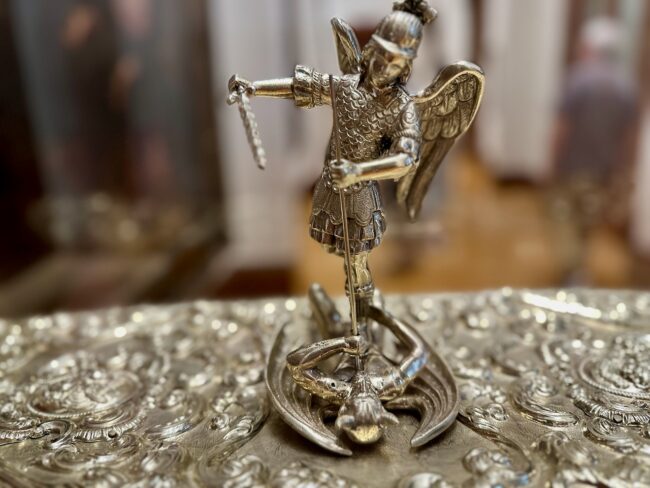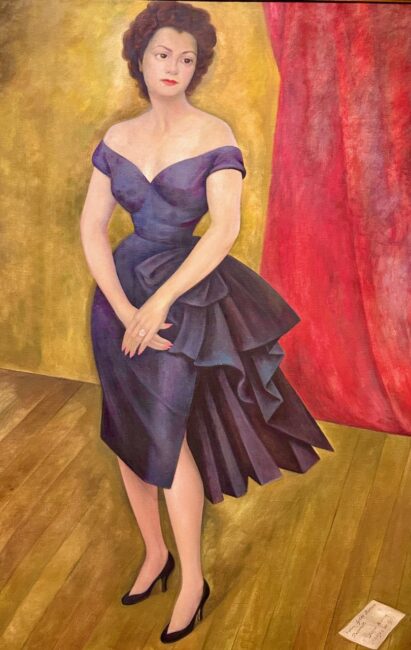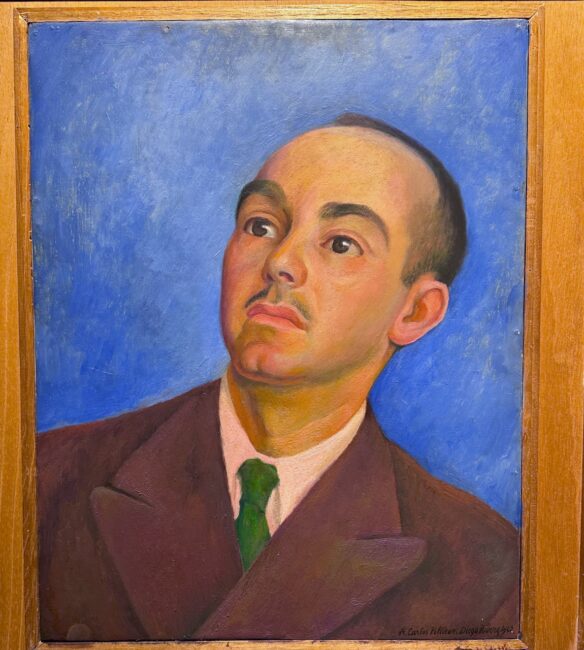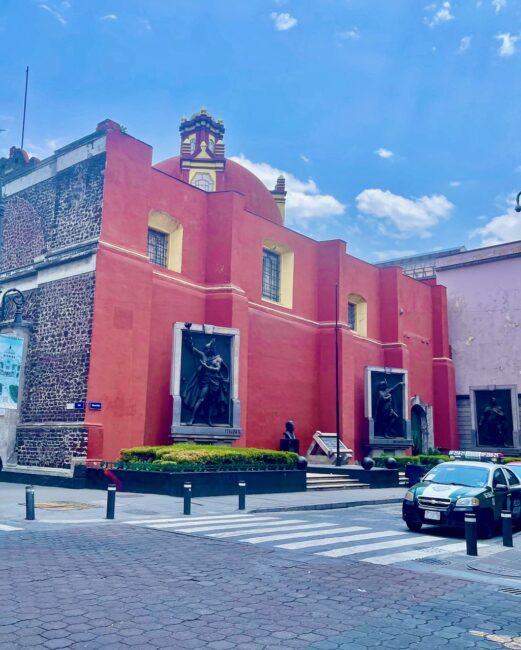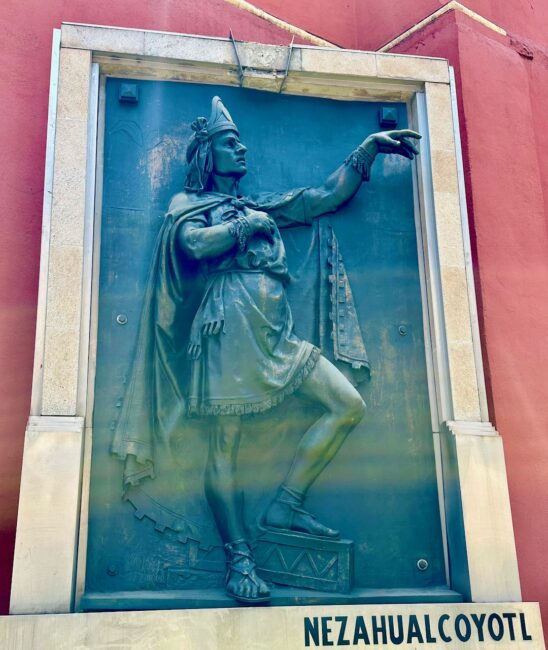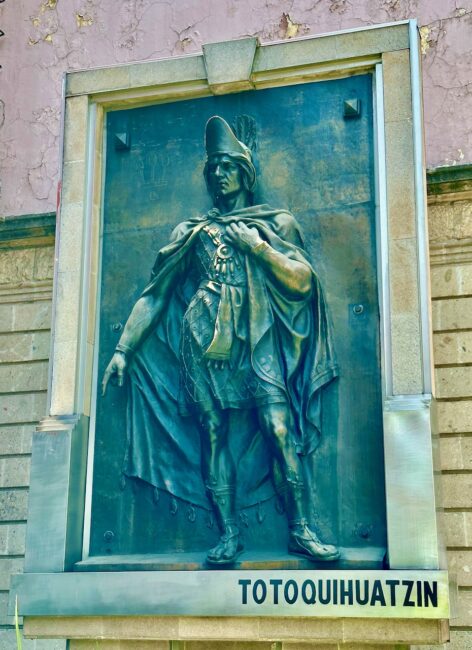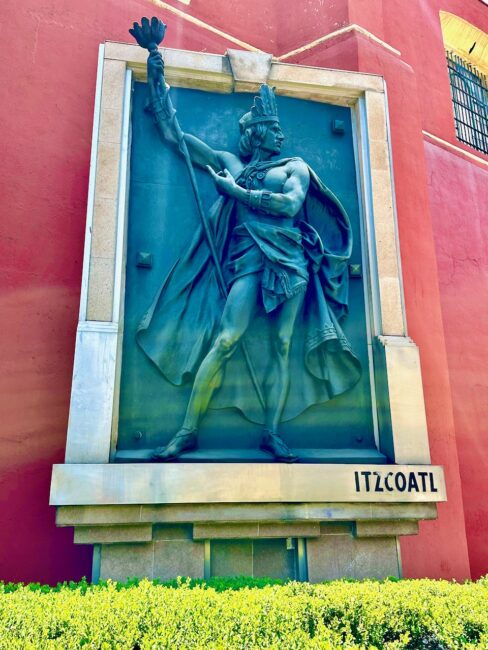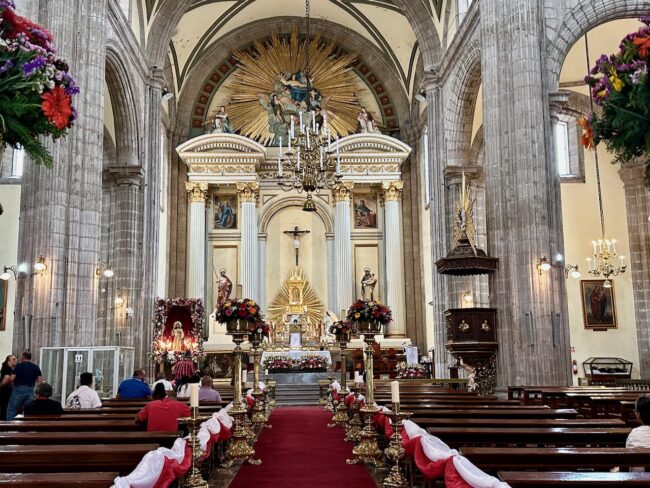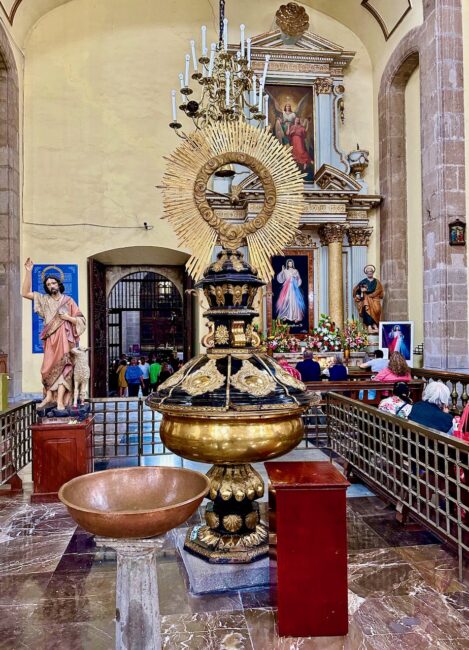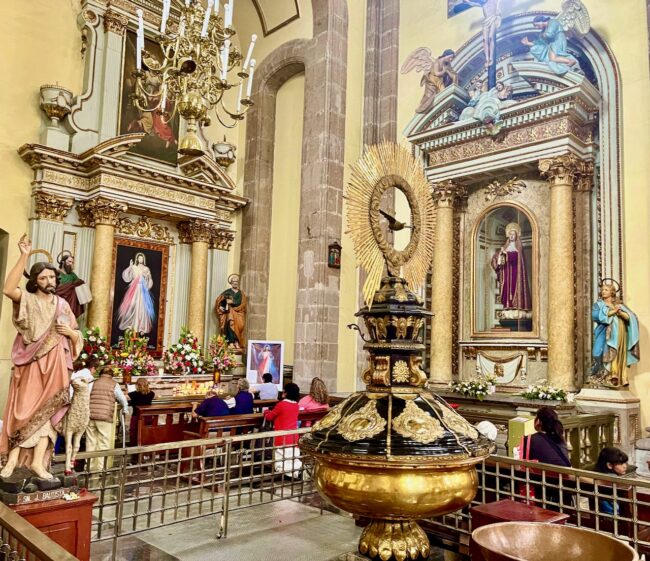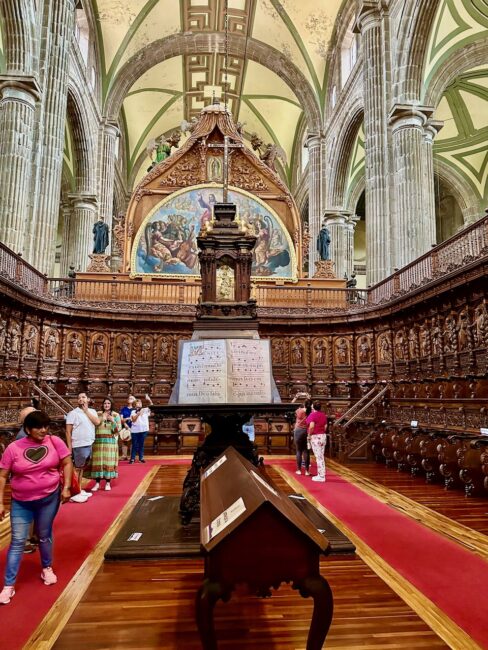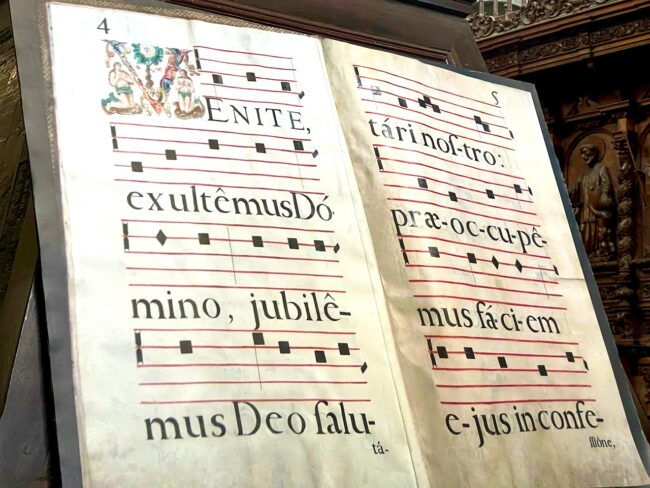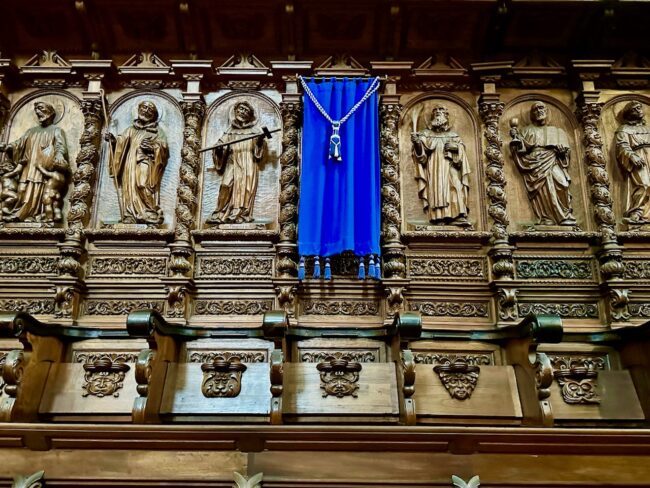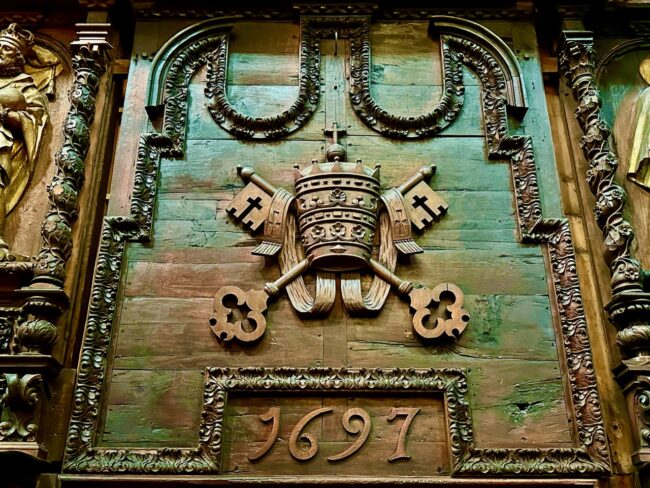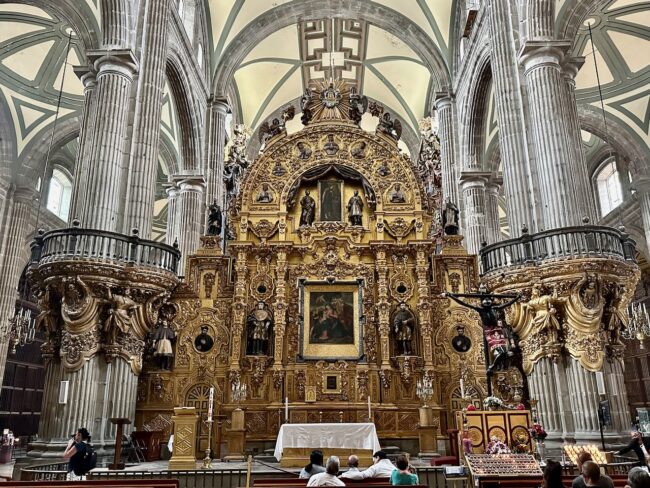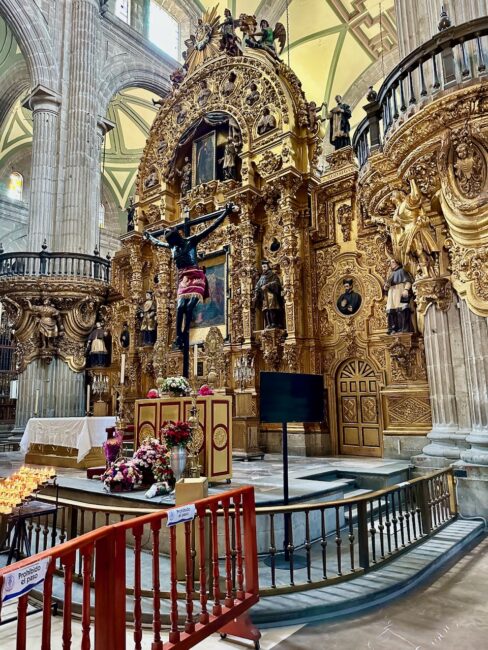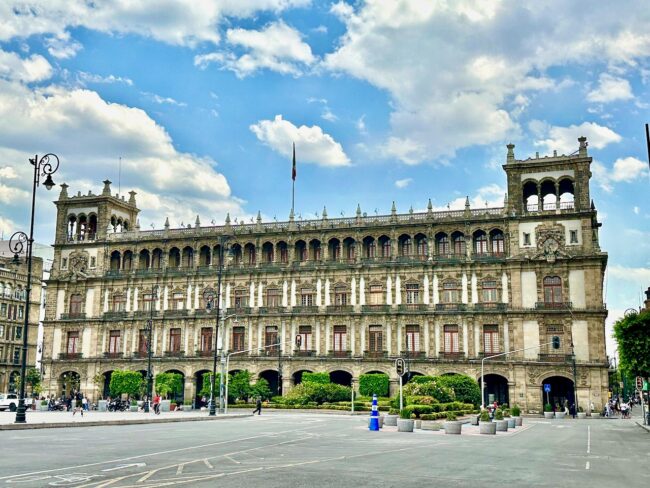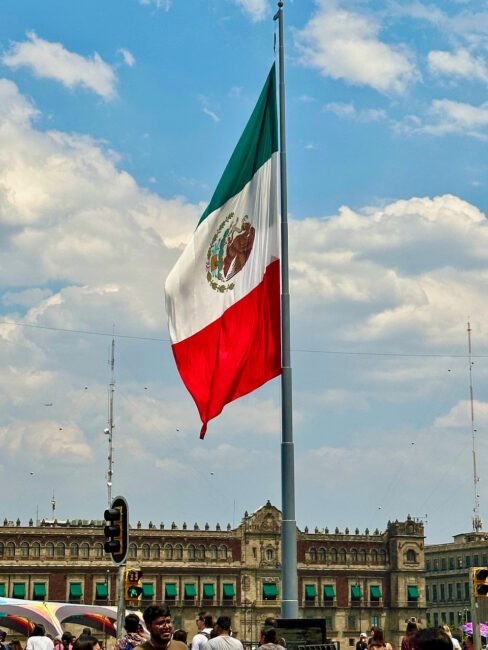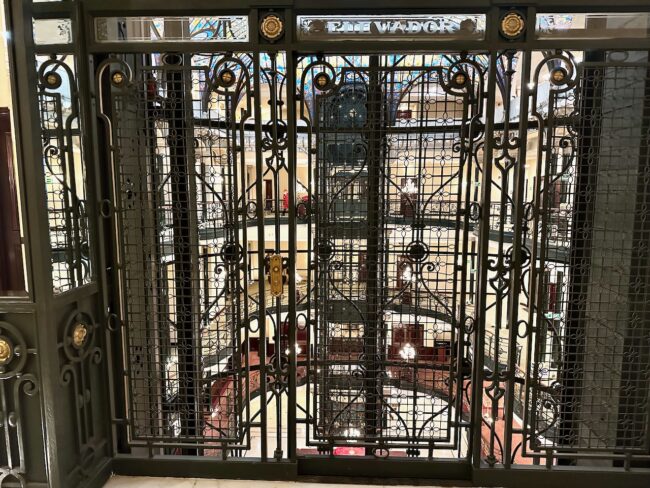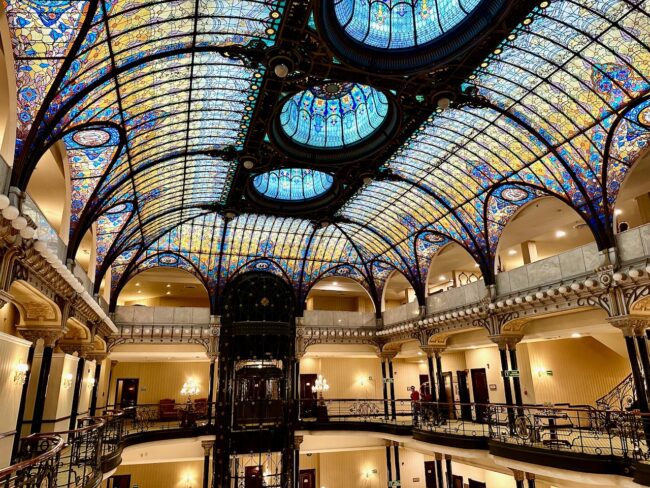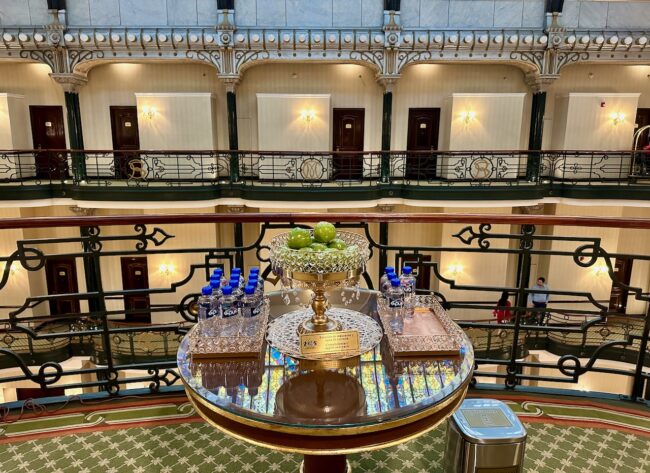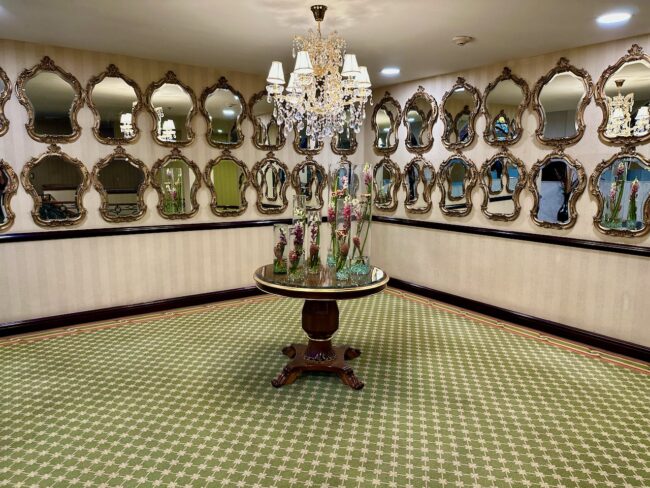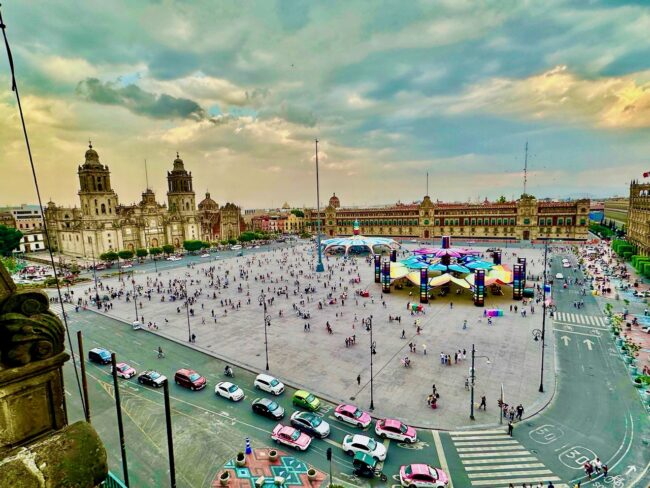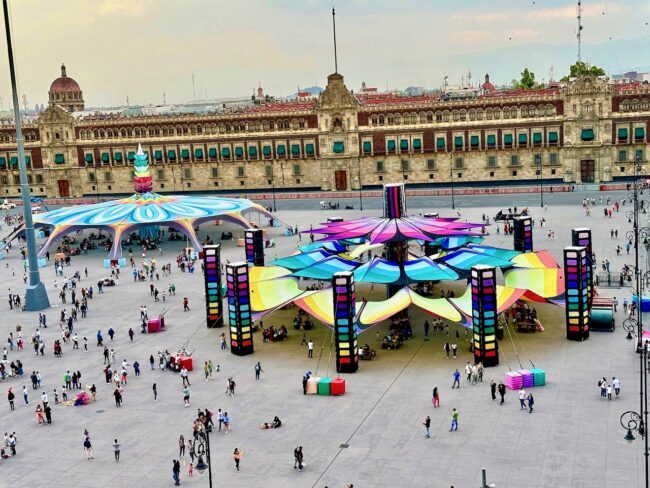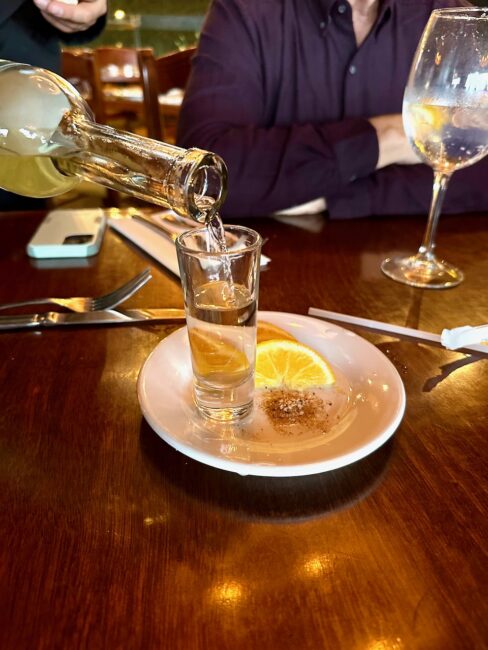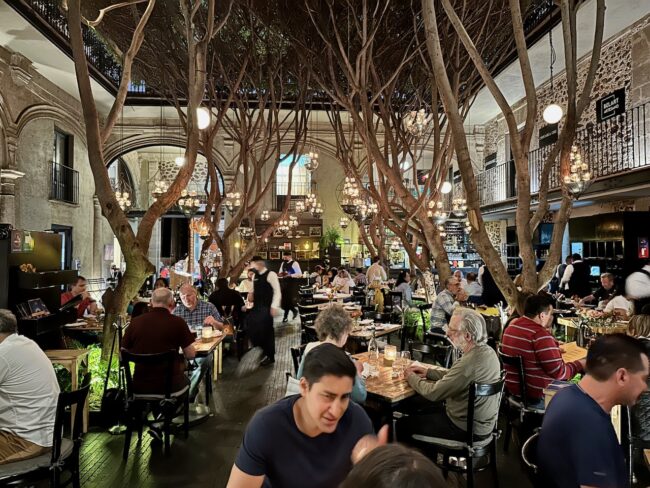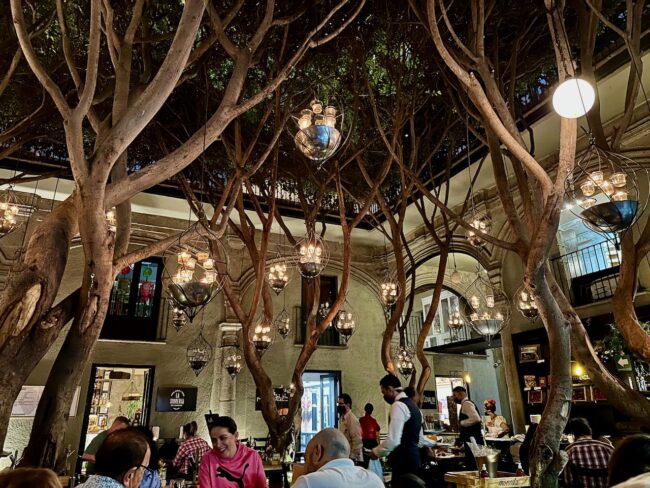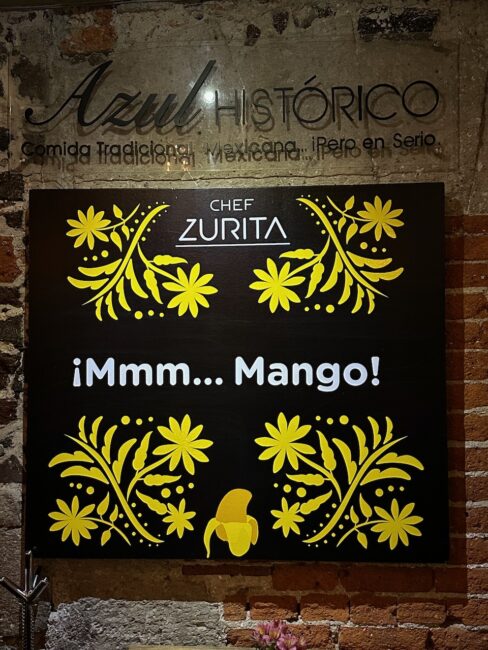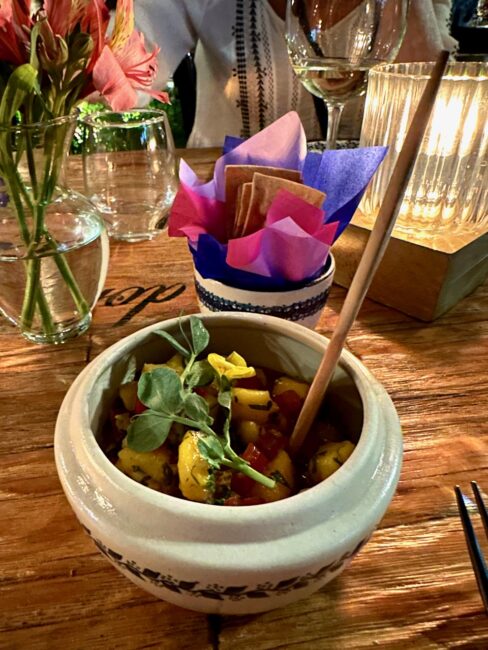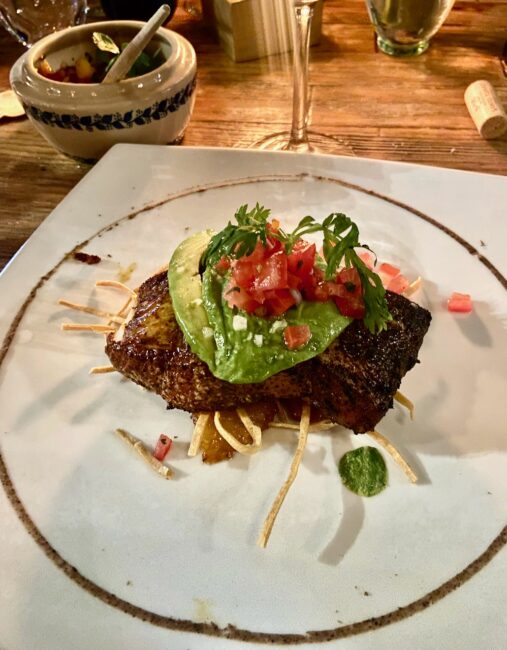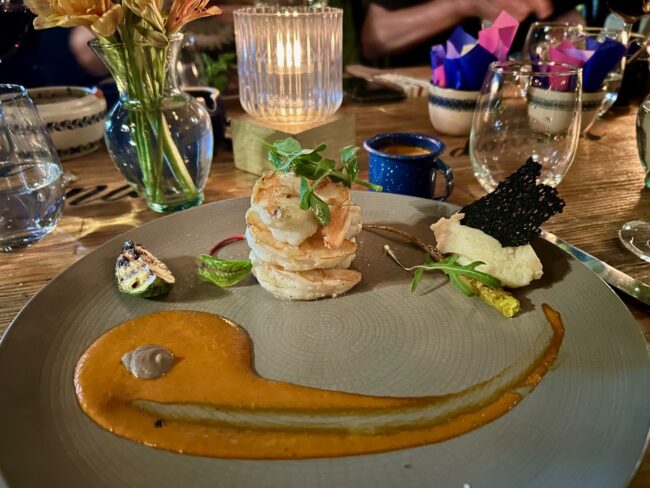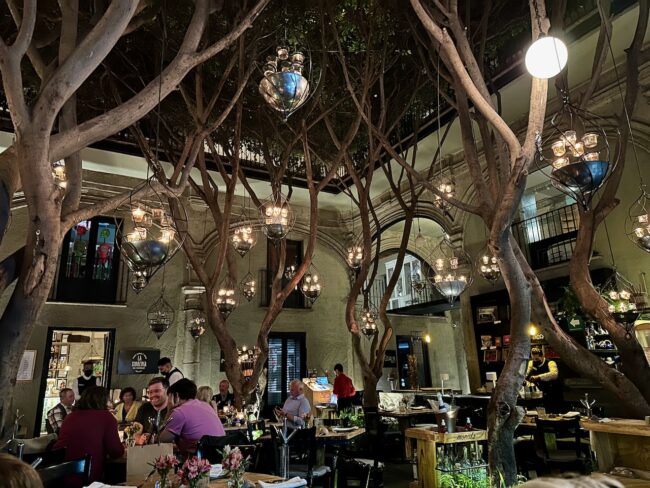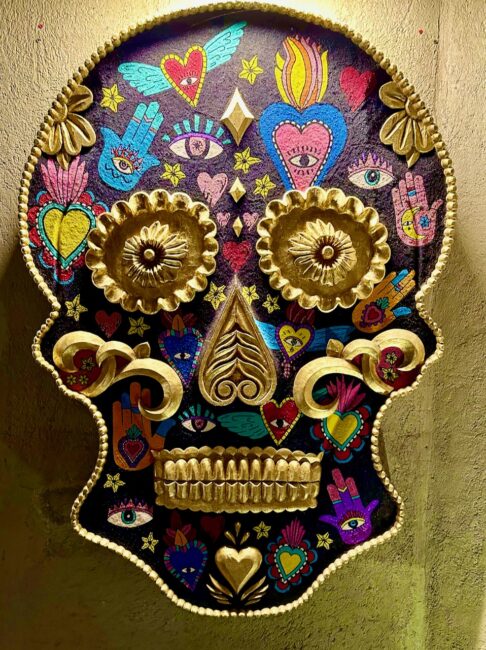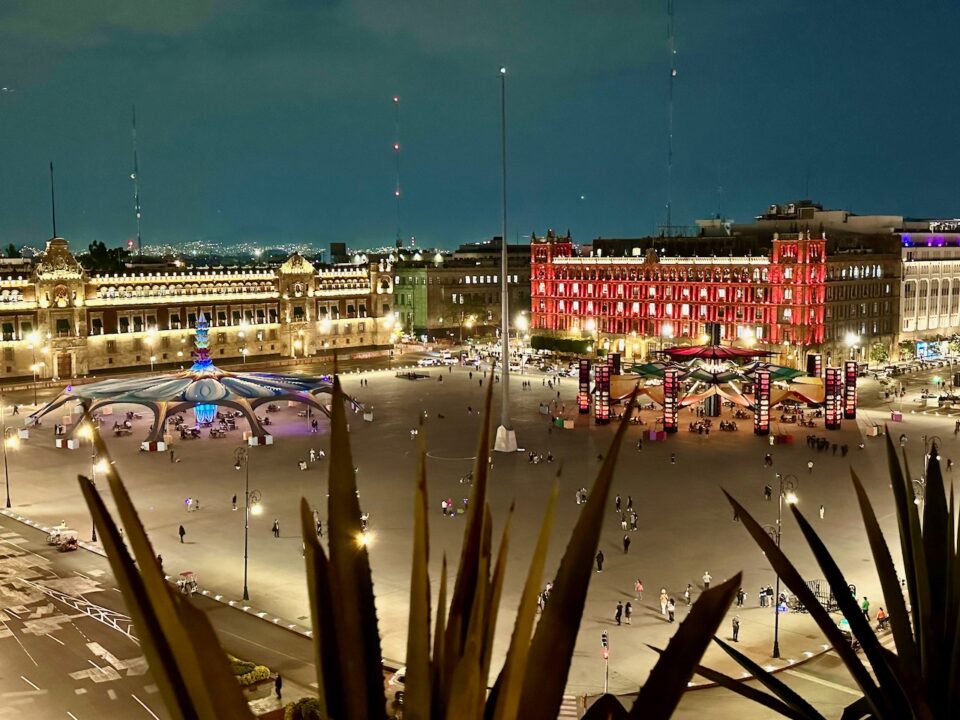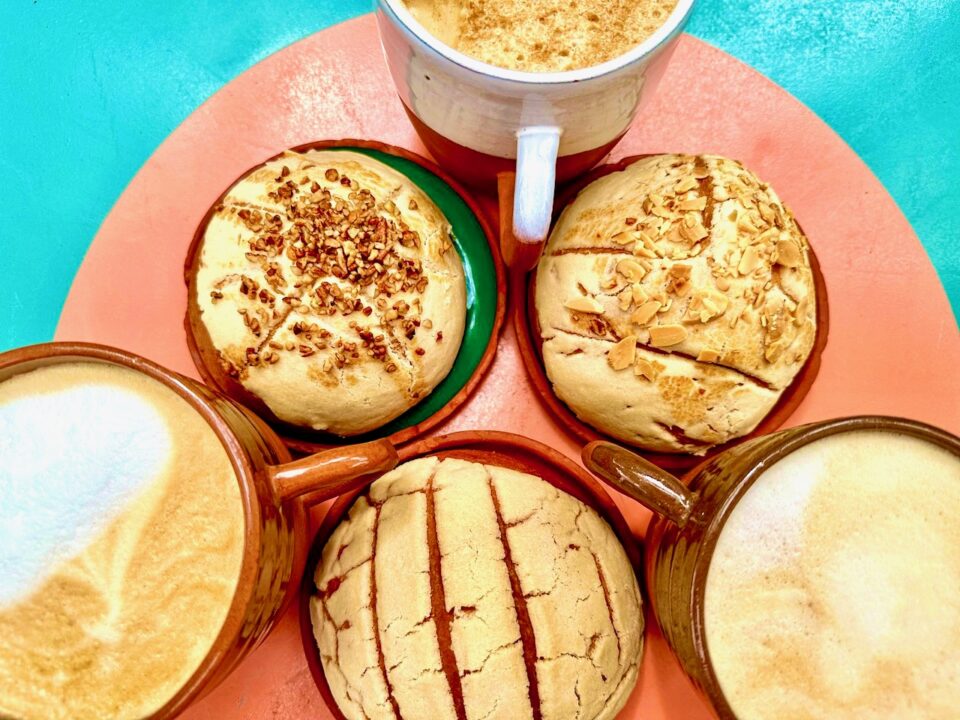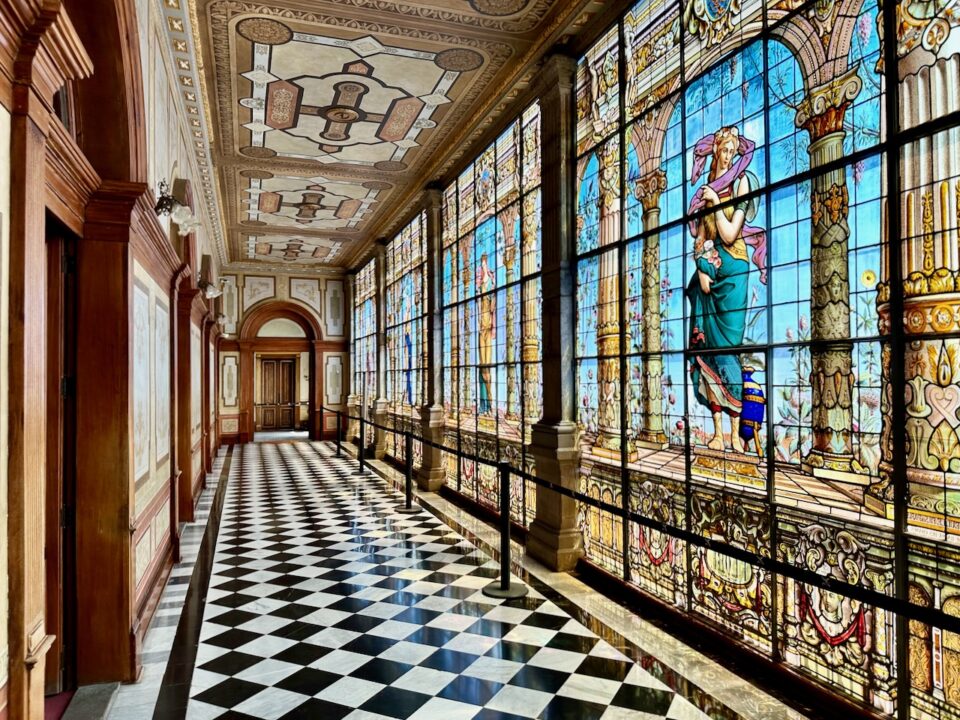
Chapters One & Two: Hola México & Checking Out A Few Mexico City Neighborhoods
May 19, 2023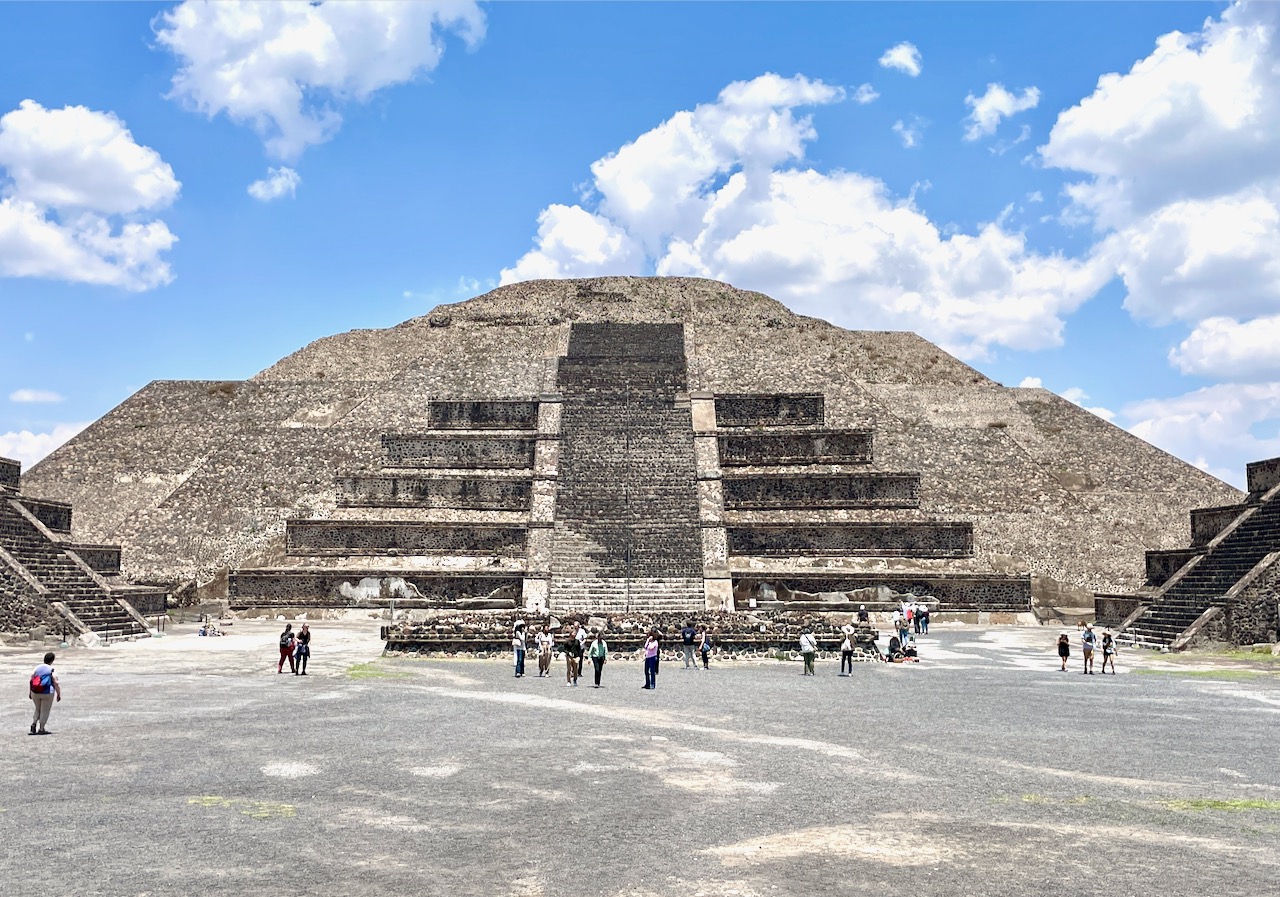
Chapter Four: Pyramid Scheme & The Miracle Cloak
June 10, 2023Historical & Hip: Mai Tai Tomás Travels To México City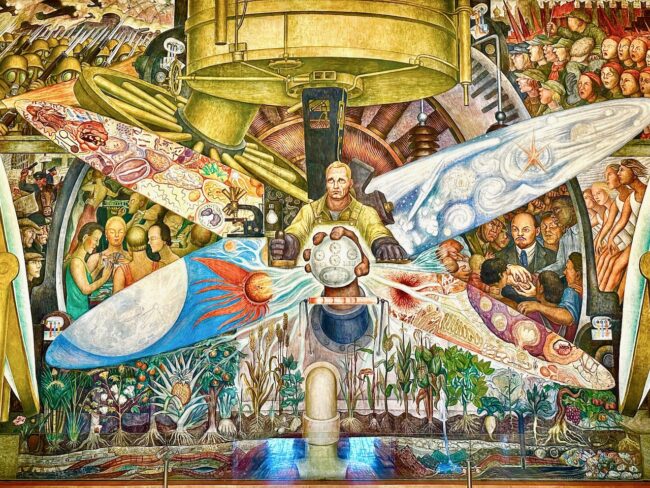
Chapter Three: Exploring Centro Histórico & Los Tres Grandes
Day Three: A Gran Tiffany Stained-Glass Ceiling, Los Tres Grandes, At The Crossroads, Hey Mr. Postman, Azulejos Restaurant, Is He Taking A Selfie?, Waiting For The Room, Carnival At The Cathedral, Champagne Welcome, Cocktails With Friends Up on The Roof, Looking Out At “The Birthplace Of The Constitution” and a Históríco Meal
It was time to switch hotels, but not before gorging on another Red Tree House breakfast, this time some tasty enfrijoladas.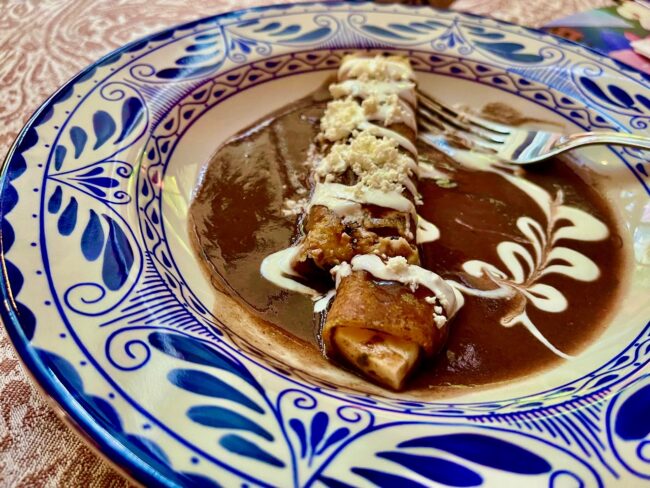
From breakfast to the Happy Hours to the artwork and stellar staff, The Red Tree House should definitely be on your list of places to stay in Mexico City.
We Ubered to the heart of Centro Histórico arriving near the Catedral Metropolitana, located on the edge of the Zócalo, Mexico City’s main plaza.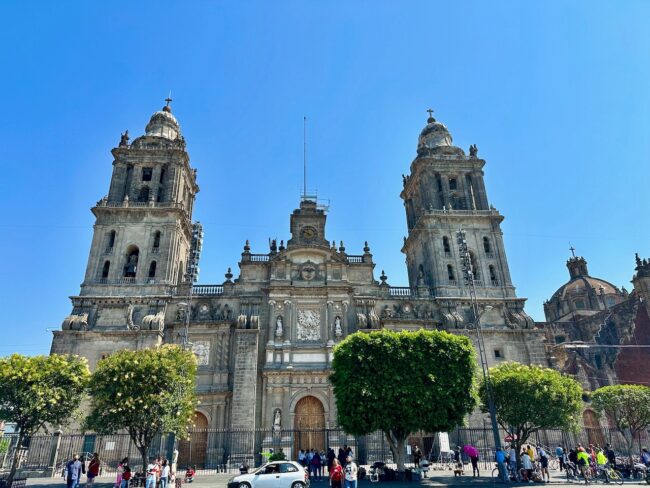
The Segundo Festival de las Flores was taking place on this weekend, making Zócalo even more festive and colorful.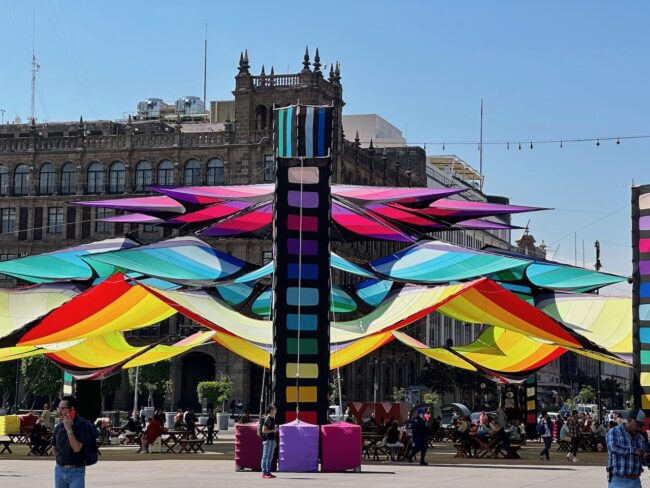
La Bandera, the gigantic Mexican flag flying above the plaza, is raised every day at 8 a.m. and lowered at sunset. Tracy took this photo later in the day when the wind unfurled the flag.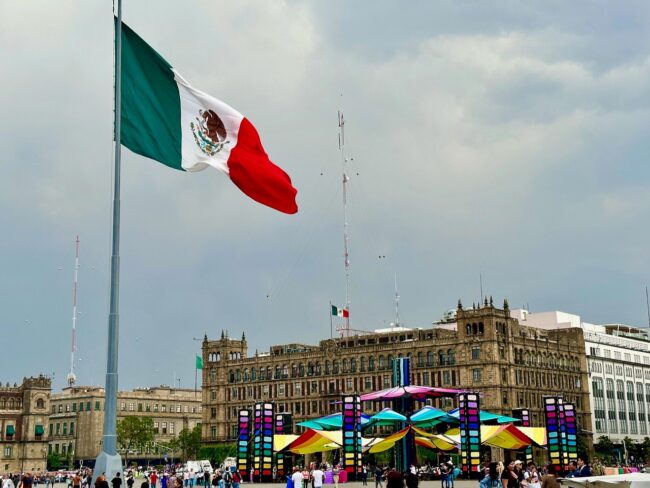
Just around the corner was the Gran Hotel Ciudad México, where we would spend the next four nights. If you want a “wow” factor upon entering a hotel, Gran Hotel Ciudad México is the place. Looking up, we admired the stunning tiffany-style stained glass dome which is one of the four largest in the world. It was created by the workshop of Jacques Gruber, a famous French woodworker and glass artist, in 1908. The colors are dazzling. We met Stephen underneath this masterpiece.
Speaking of Frenchmen, Sebastion Robert purchased the historic building, whose origins go all the way back to the 16th century, in 1895 and turned it into Mexico City’s first department store. It became a hotel in 1968 and still maintains many of its original accoutrements, including the cage-like iron elevator which was the “first of its kind in Mexico City.”
It was too early to check in, so it was off to see the sights of Centro Histórico, many of them within a short walking distance from the hotel.
We passed the Iglesia Metodista Episcpal 1873 and the nearby Sociedad Bíblica de México, which had this sculpture out front.
As we walked toward the Museo Palacio de Belle Artes, we also passed Iglesia de San Francisco, which was located on the site of Mexico City’s first convent. Only the church remains.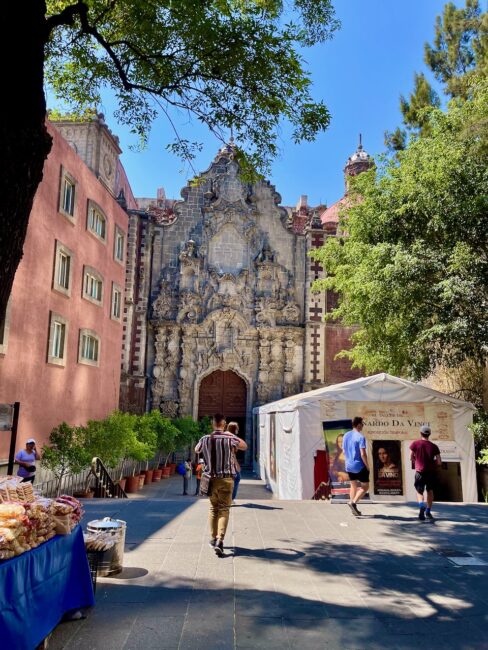
Directly across the street is the Casa de los Azulejos, which was originally built in 1596. The façade is covered in those blue and white tiles (made in Puebla) that we loved so much in Portugal last year. It was occupied by the Counts of the Valley of Orizaba and their families from the 17th to the 19th century.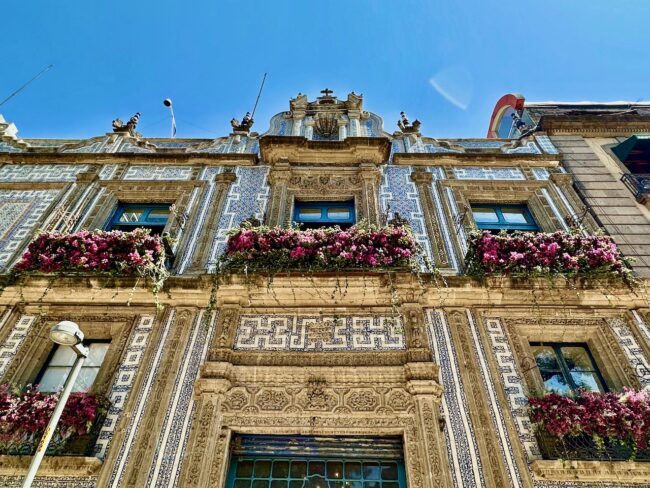
Dueling stories are told about its origin, but it is the one described in Altas Obscura that I like the best… “The tiling was the result of a dispute between a father and his son, who partied too much.” According to the story, “When the young man’s father told him he was good for nothing, he cleaned up his act, grew his fortune, and covered his family house with tiles to prove to his papa that he was at least good for making beautiful buildings.” I’ll go with that version. It now houses a Sanborns restaurant, which is a popular chain in Mexico City.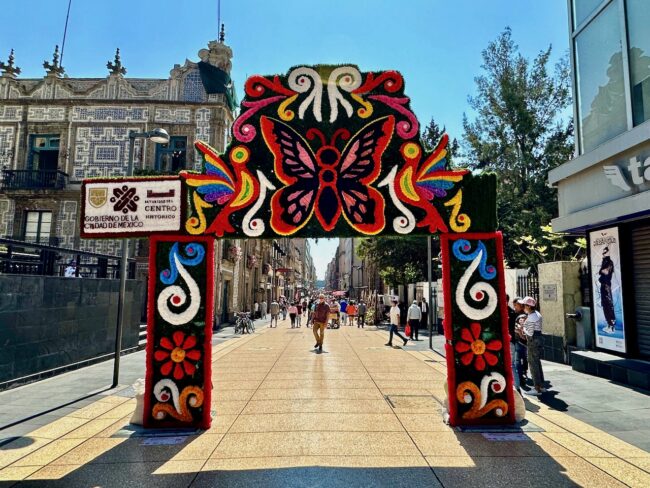
We crossed the street to the Museo & Palacio de Bellas Artes, a gorgeous neo-classical and art nouveau building from the early 20th century. In front of the building stands the Pegasus statue, which originally stood on the Zócalo.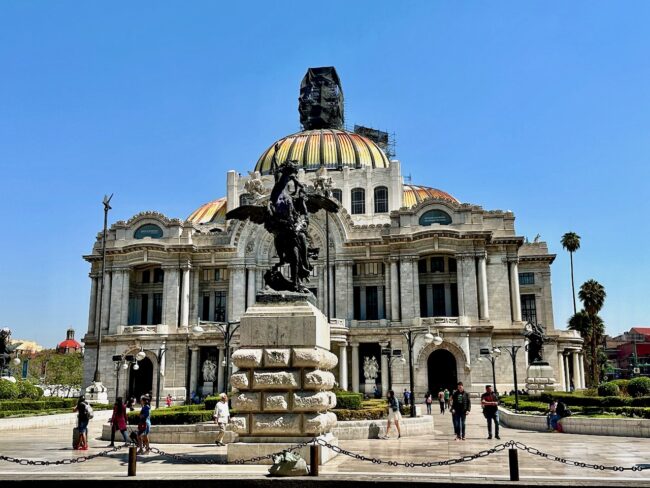
Another statue is situated between the palace and Alameda Central, the historical park we’d stroll through later in the week, of Francisco I. Madero, a revolutionary, writer and statesman in the early 20th century. He served as president, but only for a couple of years before he was overthrown in a coup d’état. Subsequently, Madero and his vice president were kidnapped, tortured and killed.The park Alameda Central is adjacent to the statue.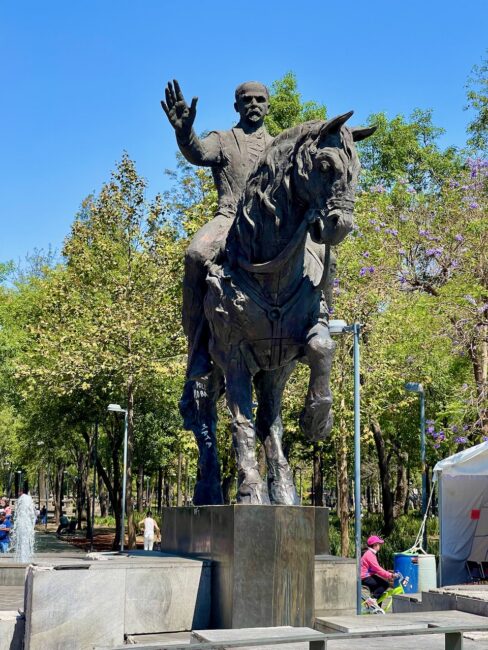
The revolutionary spirit still seems alive today as we read the words spray painted on his statue “No Vamos de Claudigar.” Although it needed some spell check, it means, “We are not going to give up.”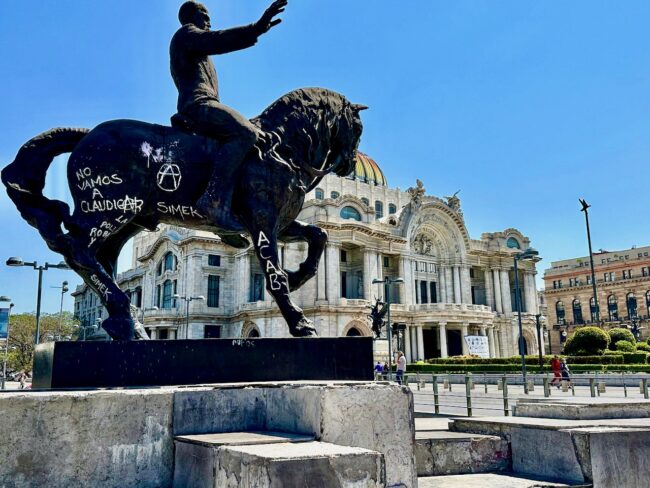
Entrance to the museum was free (minimal charge to take photos) since it was Sunday. It didn’t take long for Tracy to find the ceiling. Once again, things were looking up.
Downstairs was an exhibition of works by Federico Silva who began his career as an assistant to one of the Tres Grandes, David Alfaro Siqueiros. Silva painted murals …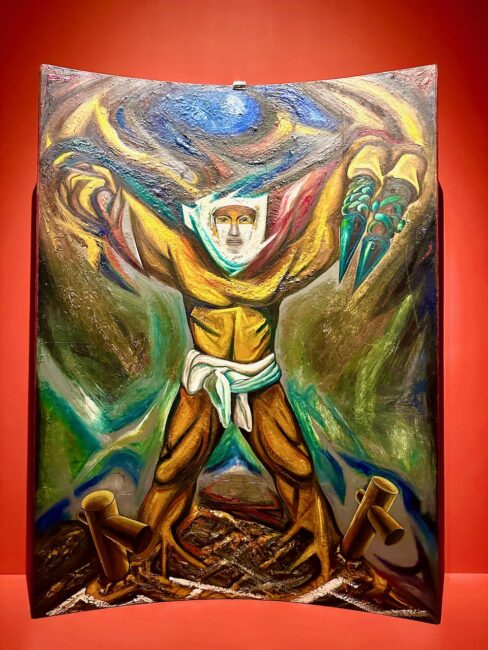
… and was also a pioneering artist in kinetic art.
I wish there had been some explanation of these. I did decipher that the one on the left is about Ezequiel Padilla Peñaloza, who was Secretary of Foreign Affairs during World War II. Many people disliked him because he was perceived as being “too pro-American.” Obviously the guys on the right weren’t very popular either.
But it is on the next floor up is where you will find the murals of Los Tres Grandes … Diego Rivera, David Alfaro Siqueiros and José Clemente Orozco, among others. Those three are the most important Mexican muralists, and they all offer their views on Mexican history among other subjects. The first mural we saw was Rivera’s controversial and famous El Hombre Controlador del Universo (Man, Controller of the Universe). (The below photo is of the entire mural, which we got from Wikipedia).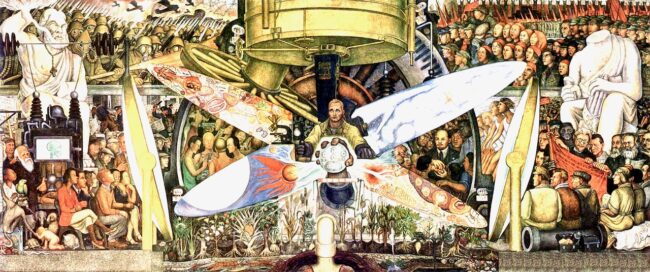
The frescoed mural depicts the conflict between capitalism and communism, with the man in the center pondering which to choose. He’s a Man At The Crossroads, which is another name for this mural. It was commissioned to be installed in the lobby of Rockefeller Center in New York City. After Rivera infuriated the Rockefellers by including a picture of Lenin, a Soviet May Day parade and John D. Rockefeller holding a drink (gasp! he was a teetotaler … he’s behind the women playing cards), Nelson Rockefeller had the mural plastered over and destroyed.
One year later, in 1934, Rivera created a second version of the three-paneled mural as “part of the inaugural program of the Palacio de Bellas Artes.” Holding the red flag are Leon Trotsky, Friedrich Engels and Karl Marx. We would visit Trotsky’s home where he was assassinated later in the week.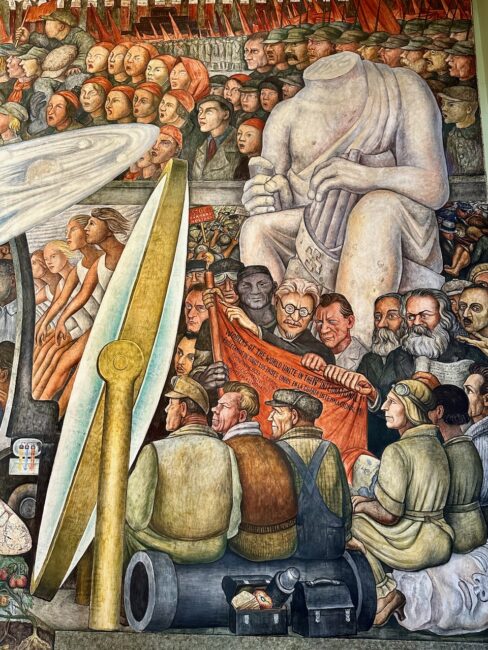
It’s an amazing mural, and we would be lucky enough to see many more Rivera murals throughout the week. The guy in the gray beard next to the skull is supposedly Charles Darwin, which proves how this mural evolved.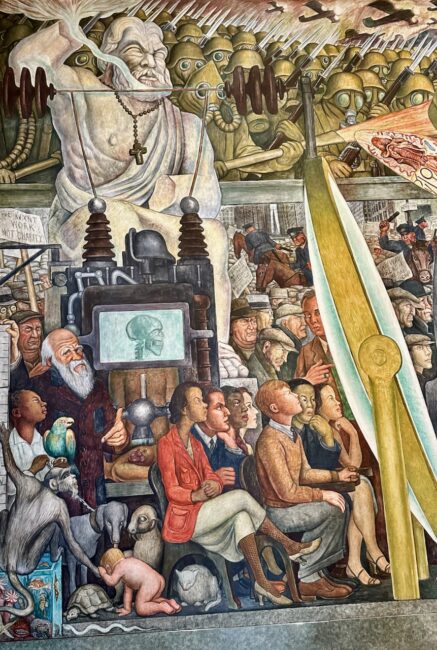
David Alfaro Siqueiros created Nueva Democracia in 1944. It commemorates the end of World War II and celebrates the Allied Forces victory. The model for this mural was Siqeiros’s wife. The mural has been interpreted as “liberation from oppression.”
Then it was back to Rivera and his Carnival de la vida Mexicana (Carnival of Mexican Life).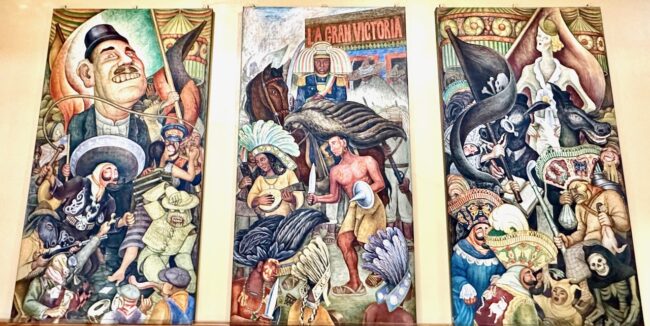
Originally, this was created to be placed in the Hotel Reforma, but was removed for its political content “satirizing the political and social landscape of the time.”
The big three was rounded out by José Clemente Orozco’s Katharsis, a “blunt criticism of war, mechanization and mass politics.” The descriptions on signs shown near the murals give you a great overview of the thoughts of the artists.
Siqueiros had two more murals that we saw. The Torment of Cuauhtémoc is pretty gruesome showing Spanish conquerors burning the feet of Cuauhtémoc (the Aztec ruler of Tenochtitlan) and Tetlepanqutzal on the orders of Cortez. Cuauhtémoc is supposed have said to Cortez, “Now I understand your false promises and the kind of death you have had in store for me. For you are killing me unjustly. May God demand justice from you, as it was taken from me when I entrusted myself to you in my city of Mexico!”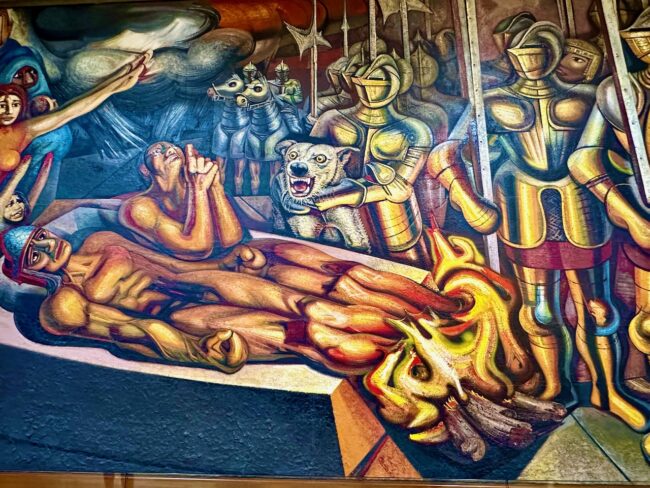
The Apotheosis of Cuauhtémoc shows the Aztec ruler in a better situation, donned in shining armor standing victorious in defeating the Spanish. Siqueiros turned the emperor into a symbol of resistance and dignity.
We admired Liberacion o La Humanidad Se Libera de la Misery by Jorge González Camerena, which is actually a re-creation of a mural that no longer exists. It was originally painted on the Edificio Guardiola, where the Bank of Mexico placed it vault.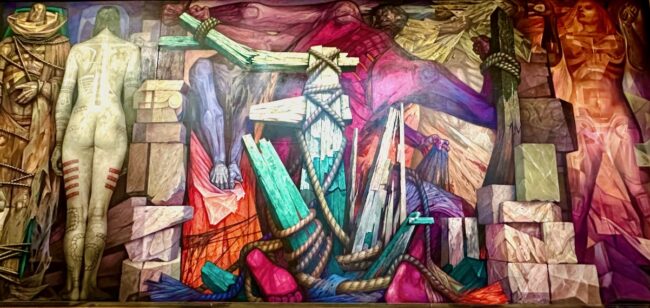
I’d read that the Belles Artes Theater where opera, symphony and Ballet Folklórico de México productions are held are only open for performances. It has a stained glass curtain depicting the Valle de México and a beautiful dome. Gotta see that sometime. (photo from wikipedia)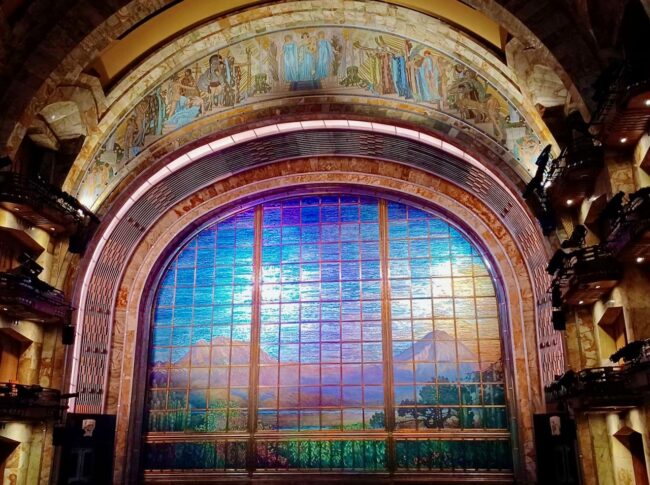
This was just the beginning of murals for our week …
… but now we had to find a post office, but not just any post office. The Palacio Postal took five years to complete (1902 – 1907) and combining Art Nouveau, Moorish, Venetian Gothic Revival, Baroque, Neoclassical and Spanish Renaissance Revival architecture, the interior is a sight to behold. The architect of this masterpiece was Italian Adamo Boari, who also just happened to be the architect of Museo & Palacio de Bellas Artes.
Beautiful staircases climb gracefully toward the ceiling. It’s the first post office where I didn’t have to stand in line.
All this, and the post office still operates today. It’s a quick stop, but a worthwhile one. It received our unanimous stamp of approval.
There was still about an hour until our next stop opened, so we wandered for a bit. In an alley we listened as an older gentleman skillfully played Viva la Vida by Coldplay on his violin.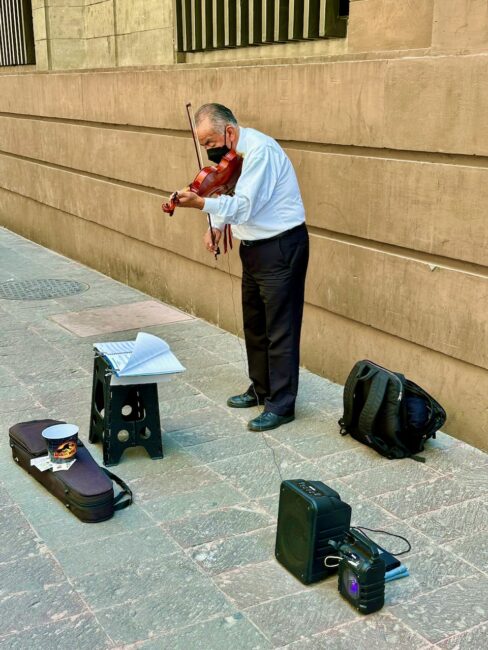
We decided to duck inside the Casa de Azulejos (aka Sanborns) to check out the interior.
In 1925 José Clemente Orozco painted murals on the staircase walls. The place was packed, so we decided to go somewhere else for a quick bite to eat, but it was fun to give it a look.
We happened to walk by a historic bar I had wanted to visit (I know, shocking), so I made a note we needed to return later in the week.
Across the street from our next stop, Museo Nacional de Arte (MUNAL), was a little pastry shop called Maison Kayser, which is also a chain. Nothing says a healthy meal like a pastry and beer. Tracy was a little more sensible, ordering a ham and cheese baguette.
Out in front of MUNAL is a large equestrian statue of Charles IV of Spain, which has been standing here for the past 220 years.
Since we needed to get back to our hotel to check in, we did not give MUNAL as much time as it warranted, but we did see a smattering of paintings and sculptures that represent the development of fine arts in Mexico.
These colorful paintings are from the mid-1900s to the late 20th century.
I think the kid on left is the one that shows up at my local market every so often.
Desserts and treats were on our plate, and I think I overheard a few snickers by some people looking at the one on the right.
As much as the art, the building is also a star.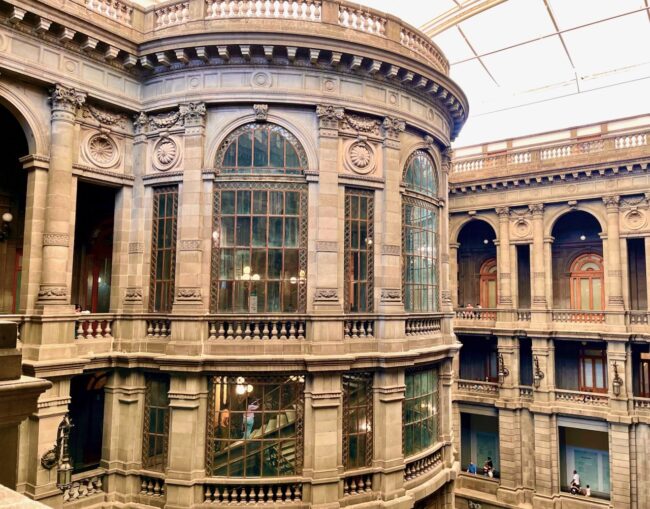
Designed by a yet another Italian architect and constructed in 1911, the building was originally Mexico City’s Palace of Communication.
The Reception Hall with its decorative ceiling was not scheduled to open until 1:30 p.m., but the nice woman at the door took pity upon us and let us in 15 minutes early.
Detail was shown throughout the building.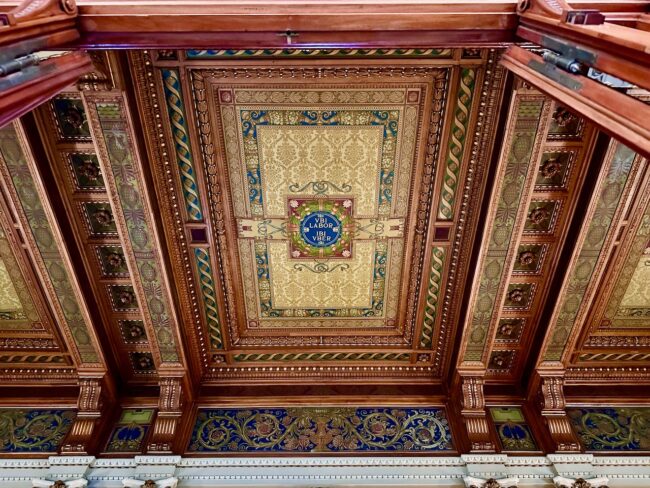
There were a couple of rooms located upstairs that we gave a quick look. It’s not often you see my friend St. Michael riding on a skateboard. He told me, “Don’t try this at home … or anywhere else!”
You cannot escape Los Tres Grandes. These two were painted by Diego Rivera.
Siqueiros created what you could call a unique “Self-Portrait.” Perhaps the first attempt at a selfie.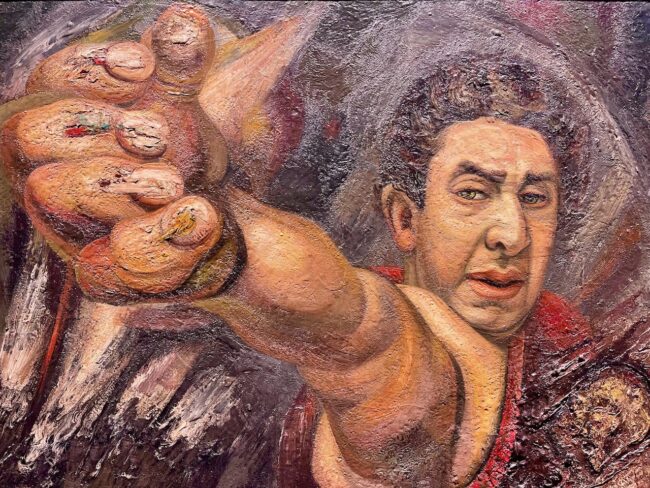
And Orozco’s “Arrowhead” … well, I don’t know what spearheaded him to paint this.. I do know that on our next visit to Mexico City we’ll spend more time here exploring all the art we did not see.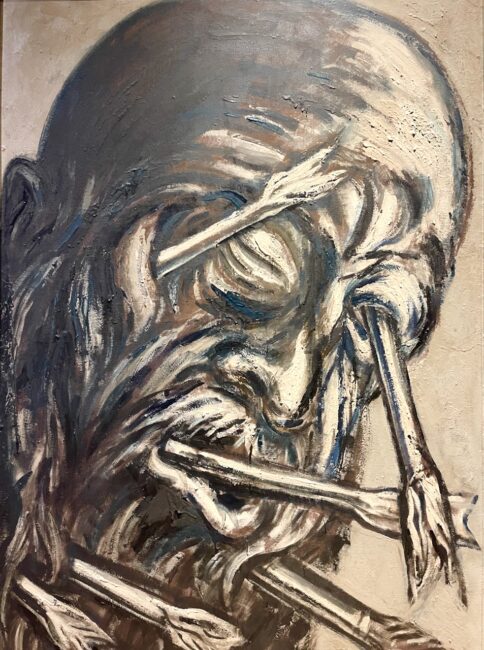
Across the street from MUNAL was a former Bethlemite church. Lined up alongside it and on another building are three statues.
They are located in the “Garden of the Triple Alliance.” According to Mexico City CDMX, “it’s a commemoration of the Triple Alliance agreed to in the year 1427 by the rulers of Tenochtitlan, Texcoco and Tlacopan.”
We walked back toward the hotel, but before checking in we decided to quickly see the interior of Catedral Metropolitana de la Asunción de María. Construction on the church began in 1567 but was not completed until 1788.
We were in one of the side chapels, and the noise sounded like a carnival (I’d find out in a few days why), while others prayed nearby.
The choir was much more peaceful.
Its Spanish organ dates from the late 1600s.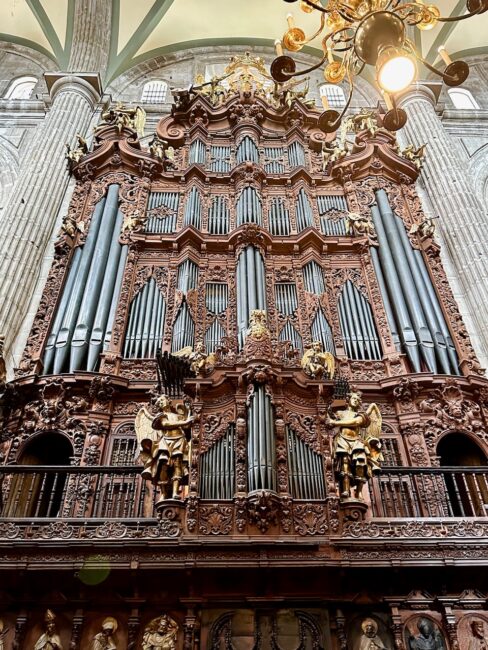
It has 59 reliefs of saints.
The chapel was off limits at this hour due to Sunday mass, but we got a couple of shots from the side and behind a barrier.
Outside is the Monumento al Papa Juan Pablo II. It was created “entirely with keys donated by Mexicans to symbolize that they had given him the keys to their hearts.” Instead of the keys to the city, he got the keys from the city.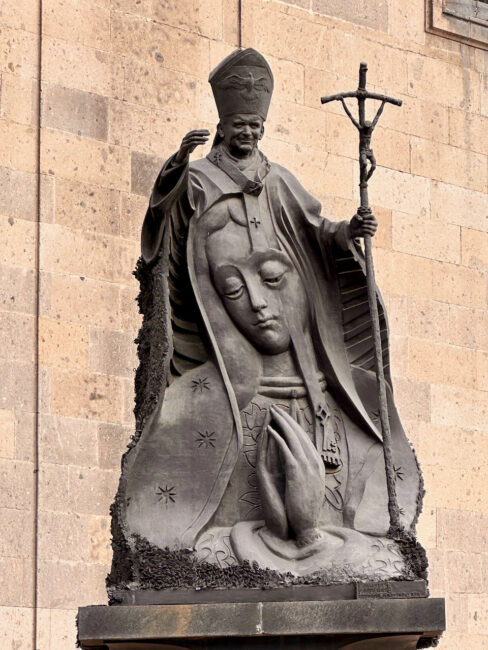
Across the Zócalo we walked, the flag was blowing in the wind.
After checking in, we rode the antique iron elevator to our floor. From here we got a different, yet just as cool, view of that spectacular ceiling.
We really couldn’t escape the ceiling since there was a picture of it over the bed.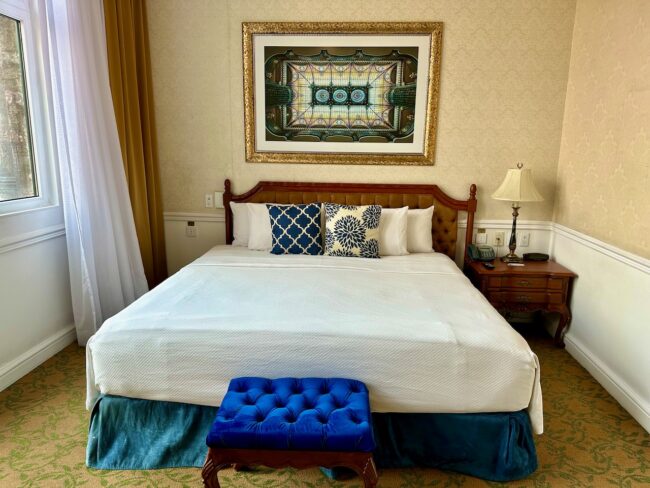
Since Mexico City’s altitude is more than 7,300 feet, it’s important to stay hydrated. The Gran Ciudad helps out with free bottles of water in the room and stacks of extra bottles nicely displayed in the hallways. It was just one of the hotel’s many amenities including a glass of champagne on check-in and a platter with chocolate covered strawberries with our name written in chocolate on it in our room.
After one of our patented 25-minute naps it was time to freshen up and head upstairs to La Terraza, Gran Ciudad’s rooftop bar and restaurant, where we’d meet up with friends Tim and Sheila, who were staying at a nearby hotel. They had spent the day at Chapultepec Park (which they said had been really crowded) and exploring the Polanco neighborhood. The view onto the Zócalo from the rooftop bar is hard to beat.
I ordered a margarita, and this was the only negative comment I have about the Gran Ciudad. It was pretty terrible, although large enough to share for the table. So when the going gets tough, the tough turn to Mezcal. That did the trick (or it at least numbed my taste buds).
One last look at the plaza and it was time for our first Centro Histórico meal. Azul Histórico (Isabel La Católica 30) is one of three Azul restaurants in Mexico City, and the dining room is stunning. With a retractable roof making you feel like you’re outside and candle-lit trees spreading over the dining room, I was glad we were eating at this branch with dishes having Mexican roots.
On our way to the table we passed a woman making delicious fresh tortillas. I would taste her work later.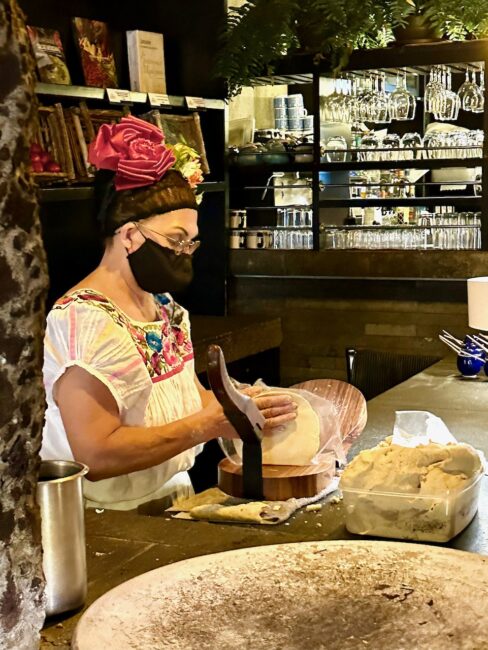
Azul Histórico features a monthly festival menu. This month mangos were highlighted. Our chips with a mango pico de gallo was a terrific start. We did not have the special mango-inspired meal, but that fruit would play an important part on our trip in a few days.
Dinner was fantastic! Being a mole aficionado, I had to try the Black Mole Enchiladas; with super Oaxacan black mole and stuffed with cheese. 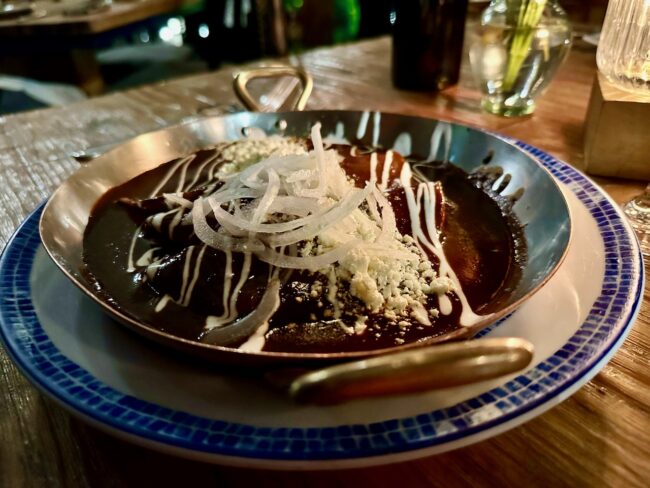
Tim ordered the Tikin Xic Fish Yucatán, a dish from the North Coast of the Yucatán Peninsula. The sea bass prepared with achiote, accompanied with plantain, avocado, tortilla strips and X-ni-pek sauce was great. Sheila had grilled shrimp with chipotle accompanied by rice and wrapped in seaweed. She said the sauce was “super yummy.”
Stephen opted for the enchiladas, too, but these were mushroom enchiladas with black mole.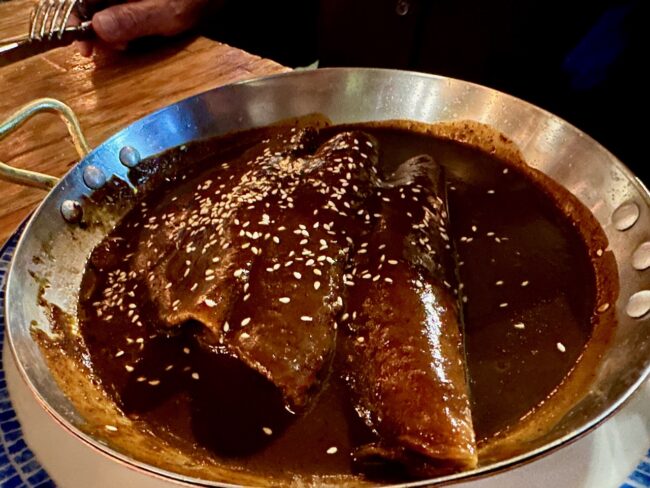
Tracy also had chipotles accompanying her delicious steak, cooked to perfection.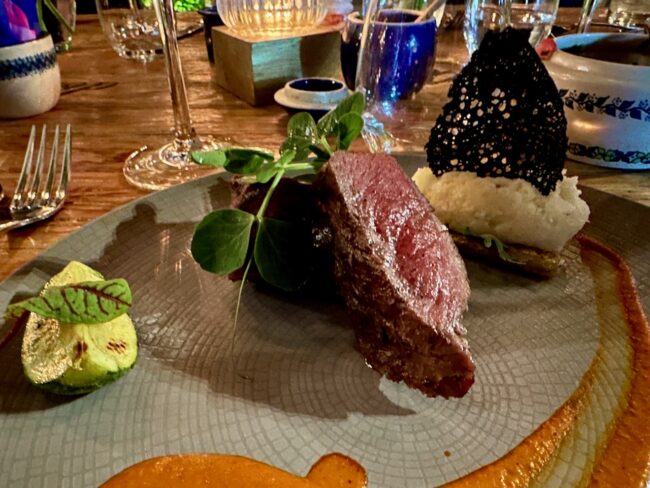
Someone at the table was yearning for dessert (he shall remain nameless, but’ he’s a sucker for desserts), and he coerced the group into sharing a Sevilla Orange Cheesecake with fresh berries. It’s how I get my 5 A Day. It was pretty small to share.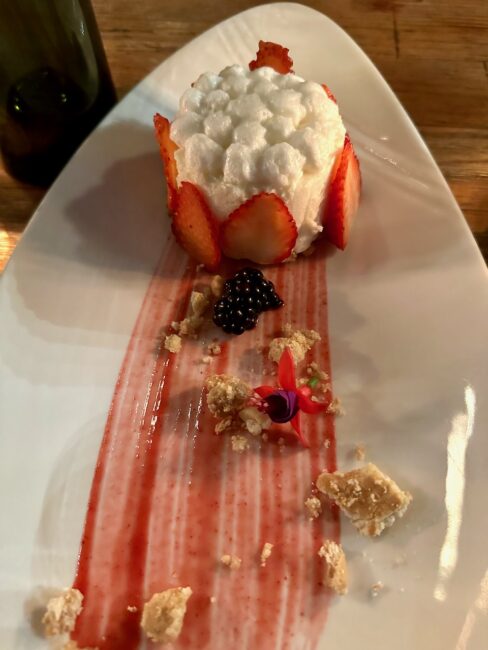
All the dishes hit the mark, and this was a great start to our Centro Histórico restaurants.
We bid Tim and Sheila “buenas noches” and would meet up with them the following evening for dinner on their hotel rooftop.
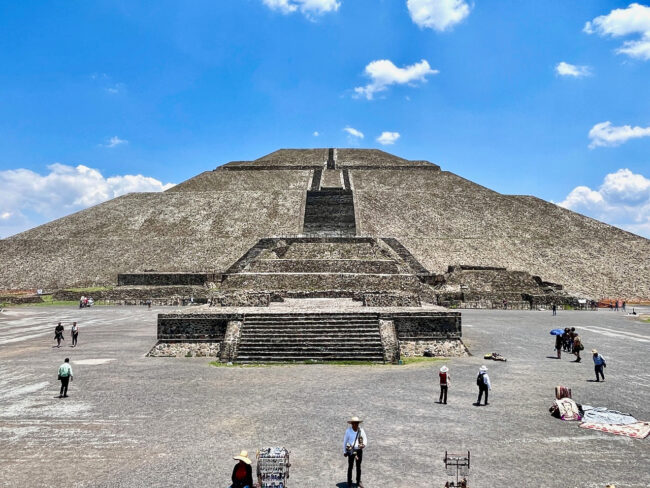 Stephen, Tracy and I would catch an early bus to visit an excavated Aztec archaeological site, the Pyramids of the Sun and the Moon including Calzada de los Muertos, plus a stop at the second most visited shrine to the Virgin Mary in the world. In between, we tasted some mezcal while making a purchase that Tracy does on almost every vacation.
Stephen, Tracy and I would catch an early bus to visit an excavated Aztec archaeological site, the Pyramids of the Sun and the Moon including Calzada de los Muertos, plus a stop at the second most visited shrine to the Virgin Mary in the world. In between, we tasted some mezcal while making a purchase that Tracy does on almost every vacation.
Meanwhile, Tim and Sheila would explore the Condesa and Roma Norte neighborhoods. They would coin a phrase that will soon spread across the world like wildfire.
I almost forgot. While at the pyramids, I did something that might be the most embarrassing thing I have ever done in front of other people (not an easy feat). It’s one that I hope will never be topped.
Next: Chapter Four: Pyramid Scheme
Day Four: Go Aztecs, Drinking & Shopping, Over The Moon, Under The Mexican Sun, Red Lobster, Hat Trick, Let It Slide, Sacred Site, People Mover Shrine, “Ambiancing” Condesa, A Very Confused Bartender and Zócalo View Dining

